Motorola Mobility T56GU1 Portable Cellular/ PCS CDMA Transceiver with BT User Manual Z6m CDMA
Motorola Mobility LLC Portable Cellular/ PCS CDMA Transceiver with BT Z6m CDMA
Exhibit 8 Users Manual
Dummy Page - To be discarded before printing
Use this template with A6MotoLandscape StructApps.
This template provides formatting for a User Guide and an embedded Legal Guide.
All semantically-named elements within the Legal Guide content must have their
Role attributes set to LG.
Z6m CDMA 02/27/07

1
HELLOMOTO
Introducing your new
MOTO
RIZR™ Z6m CDMA wireless phone!
Connect on So Many Levels
– Whether it’s work or friends, connect in a variety of ways – voice,
messaging, downloads, or swapping an optional memory card – you’ll be on top of all the latest
news and views to share!
Rich Multimedia Experience
– Use the robust music player to set your playlist for your morning
commute. Slip a microSD card into the removable memory slot to save many more songs!
An easy to use digital camera lets you take great quality pictures. Save images on your phone or
on the memory card. Or instead, make a mini-movie with the video camera, if you prefer.
Handsfree Convenience
– Use your phone with Bluetooth® wireless headsets to hear calls
or music.
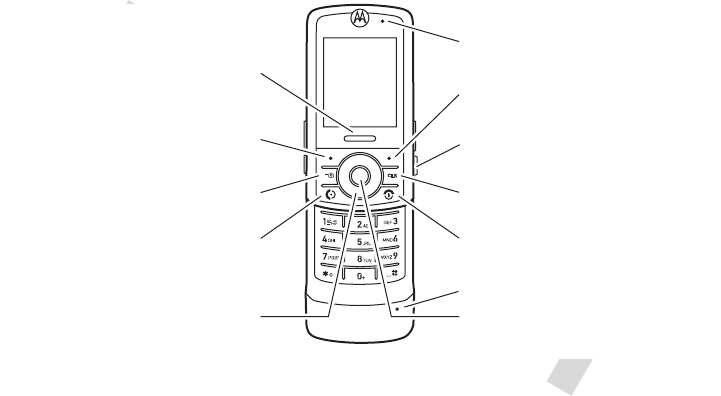
2
Here’s a quick anatomy lesson.
J
I
H
G
Center Key
Open main menu & select menu items.
Right Soft Key
Clear/Back Key
Power/End Key
Turn on/off, hang up, exit menus.
Camera Key
Left Soft Key
Send Key
Make & answer calls.
Navigation Key
Scroll up, down, left, or right.
Push Bar
Push down to close slider.
Lock Switch
Light Sensor
Microphone
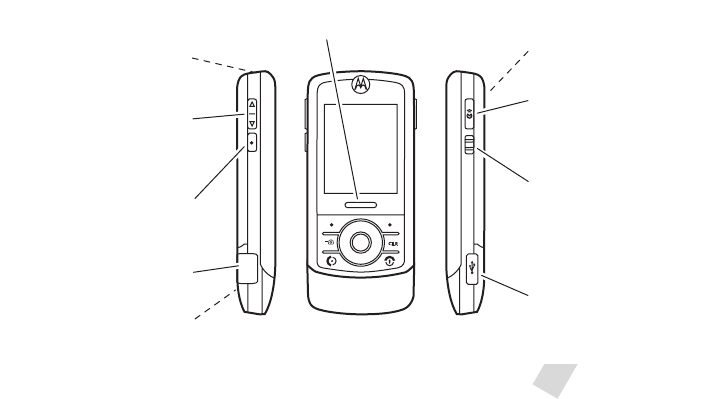
3
\
Handsfree Speaker
(on back of phone)
Volume Keys
Set ring volume when
slider is closed.
Smart/Seakerphone Key
Select menu items.
Push Bar
Push up to open slider.
Camera Lens
(on back of phone)
Lock Switch
Lock the slider to prevent
accidental key presses.
Mini-USB Port
Insert battery charger
& phone accessories.
Voice Command Key
Use voice commands to make
calls & perform basic phone
functions.
3.5mm Headset Jack
MicroSD
Memory Card Slot
(on top of phone)
J
I
H
G
>
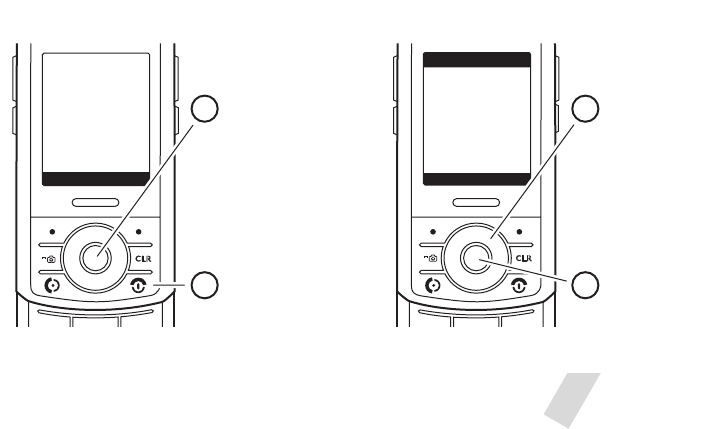
4
This is the standard main menu layout.
Your phone’s menu may be a little different.
To change your home screen shortcuts and main menu appearance, see page 83.
N
0
❙❙❙
P
OK
❙❙❙
6Îì
MON 1/15/07
8:45am
Recent Messaging
0
❙❙❙
P
Select Exit
se
JLh
w
É
Recent Calls
m
n
L
h
J
e
&
&
&
&
Home Screen Main Menu
Press & hold the
Power Key
P
until
the display lights up,
to turn on your
phone.
1
Press the
Center Key
s
to select it.
4
Press the
Navigation Key
S
up/down/left/right to
highlight a menu
feature.
3
Press the
Center
Key
s
to open
the
Main Menu
.
2
J
I
H
G
J
I
H
G

5
Motorola, Inc.
Consumer Advocacy Office
1307 East Algonquin Road
Schaumburg, IL 60196
www.hellomoto.com
1-800-331-6456 (United States)
1-888-390-6456 (TTY/TDD United States for hearing impaired)
1-800-461-4575 (Canada)
Certain mobile phone features are dependent on the capabilities
and settings of your service provider’s network. Additionally,
certain features may not be activated by your service provider,
and/or the provider’s network settings may limit the feature’s
functionality. Always contact your service provider about feature
availability and functionality. All features, functionality, and other
product specifications, as well as the information contained in this
user’s guide are based upon the latest available information and
are believed to be accurate at the time of printing. Motorola
reserves the right to change or modify any information or
specifications without notice or obligation.
MOTOROLA and the Stylized M Logo are registered in the US
Patent & Trademark Office. All other product or service names are
the property of their respective owners. The Bluetooth trademarks
are owned by their proprietor and used by Motorola, Inc. under
license. Java and all other Java-based marks are trademarks or
registered trademarks of Sun Microsystems, Inc. in the U.S. and
other countries. Microsoft and Windows are registered trademarks
of Microsoft Corporation; and Windows XP is a trademark of
Microsoft Corporation.
© Motorola, Inc., 2007.
Caution:
Changes or modifications made in the radio phone, not
expressly approved by Motorola, will void the user’s authority to
operate the equipment.
Software Copyright Notice
The Motorola products described in this manual may include
copyrighted Motorola and third-party software stored in
semiconductor memories or other media. Laws in the United
States and other countries preserve for Motorola and third-party
software providers certain exclusive rights for copyrighted
software, such as the exclusive rights to distribute or reproduce
the copyrighted software. Accordingly, any copyrighted software
contained in the Motorola products may not be modified,
reverse-engineered, distributed, or reproduced in any manner to
the extent allowed by law. Furthermore, the purchase of the
Motorola products shall not be deemed to grant either directly or
by implication, estoppel, or otherwise, any license under the
copyrights, patents, or patent applications of Motorola or any
third-party software provider, except for the normal, non-exclusive,
royalty-free license to use that arises by operation of law in the
sale of a product.
Manual Number: 6809509A46-O

6
contents
contents
menu map . . . . . . . . . . . . 8
Use and Care . . . . . . . . . 10
essentials . . . . . . . . . . . . 11
about this guide. . . . . . 11
battery . . . . . . . . . . . . . 12
turn it on & off . . . . . . . 14
lock & unlock slider . . . 14
make a call. . . . . . . . . . 15
answer a call . . . . . . . . 15
adjust volume . . . . . . . 15
change the call alert. . . 15
store a phone
number . . . . . . . . . . . . 16
call a stored phone
number . . . . . . . . . . . . 16
view your phone
number . . . . . . . . . . . . 16
tips & tricks . . . . . . . . . . 17
basics . . . . . . . . . . . . . . . 18
home screen . . . . . . . . 18
shortcuts & main
menu . . . . . . . . . . . . . . 20
enter text. . . . . . . . . . . 22
slider closed . . . . . . . . 27
continue or end task
when closing slider . . . 28
handsfree speaker. . . . 29
codes & passwords. . . 30
lock & unlock phone . . 30
airplane mode . . . . . . . 31
memory card . . . . . . . . 31
customize. . . . . . . . . . . . 38
ring styles & alerts. . . . 38
wallpaper . . . . . . . . . . . 39
set screen saver . . . . . 39
brightness . . . . . . . . . . 40
backlight . . . . . . . . . . . 40
talking phone settings . 40
AGPS & your location . 41
AGPS limitations
& tips . . . . . . . . . . . . . . 42
calls. . . . . . . . . . . . . . . . . 44
turn off a call alert . . . . 44
redial a number . . . . . . 44
automatic redial . . . . . . 44
recent calls . . . . . . . . . 44
return a missed call . . . 46
answer options . . . . . . 46
notepad . . . . . . . . . . . . 46
attach number . . . . . . . 46
(continued next page)

contents
7
messages (continued)
emergency calls . . . . . 47
AGPS during an
emergency call . . . . . . 47
speed dial . . . . . . . . . . 48
voicemail . . . . . . . . . . 49
messages . . . . . . . . . . . 50
send a multimedia
message. . . . . . . . . . . 50
receive a multimedia
message. . . . . . . . . . . 53
connections . . . . . . . . . 55
Bluetooth®
connections . . . . . . . . 55
cable connections. . . . 58
entertainment. . . . . . . . 59
music player . . . . . . . . 59
take & send photo . . . 71
record & play video
clips . . . . . . . . . . . . . . . 74
other features . . . . . . . . 76
advanced calling . . . . . 76
phonebook . . . . . . . . . 76
messages . . . . . . . . . . 79
personalize . . . . . . . . . 81
call times . . . . . . . . . . 86
handsfree . . . . . . . . . . 86
data & fax calls . . . . . . 88
network . . . . . . . . . . . 89
personal organizer . . . 89
security. . . . . . . . . . . . 91
fun & games. . . . . . . . 92
service & repairs. . . . . . 94
SAR Data. . . . . . . . . . . . 95
Safety Information . . . . 98
Industry Canada
Notice . . . . . . . . . . . . . 103
FCC Notice . . . . . . . . . 104
Warranty . . . . . . . . . . . 105
Hearing Aids . . . . . . . . 109
WHO Information . . . . . 110
Registration . . . . . . . . . 110
Export Law . . . . . . . . . . 111
Recycling. . . . . . . . . . . . 111
Perchlorate Label . . . . 112
Driving Safety . . . . . . . 113
index . . . . . . . . . . . . . . 115

8
menu map
menu map
main menu
n
Contacts
s
Recent Calls
• Received
• Dialed
• Notepad
• Call Times
•Data Times
•Data Volumes
e
Messaging
• Create Message
• Message Inbox
•Voicemail
• Browser Alerts
• Outbox
•Drafts
• Templates
J
BREW
L
Web Browser
h
Media Gallery
•Camera
• MP3 Player
•Pictures
• Sounds
• Videos
• Video Camera
• Themes
w
Settings
• (see next page)
* optional features
This is the standard main menu layout.
Your phone’s menu may be a
little different
.
É
To o l s
•Calculator
• Datebook
•Voice Records
•Alarm Clock
• Airplane Mode
m
Phone Status
• My Tel. Number
• Battery Meter
• Storage Devices
• Other Information

menu map
9
settings menu
t
Ring Styles
•Style
•Style Detail
l
Personalize
• Home Screen
• Main Menu
•Voice Dial Setup
•Skin
• Greeting
• Wallpaper
• Screen Saver
• Slide Tone
• Sound Settings
U
In-Call Setup
• In-Call Timer
• Answer Options
•MSG Alert
Æ
Security
• Phone Lock
• Lock Application
• Restrict Calls
• New Passwords
Z
Initial Setup
• SpeakerPhone
• Auto Redial
• Backlight
• TTY Setup
•Scroll
• Slide Closed
• Language
• Battery Save
• Brightness
•DTMF
• Hyphenation
• Master Reset
• Master Clear
j
Network
• Current Network
• Set Mode
• Service Tone
• Call Drop Tone
J
Car Settings
• Auto Answer
• Auto Handsfree
• Power-off Delay
• Charger Time
S
Headset
• Auto Answer
• Voice Dial
P
Location
L
Connection
• Incoming Call
• Bluetooth Link
• USB Settings
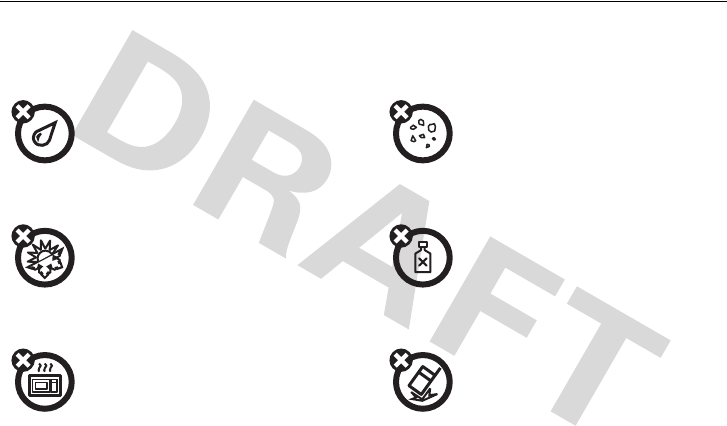
10
Use and Care
Use and Care
Use and Care
To care for your Motorola phone, please keep it away from:
liquids of any kind dust and dirt
Don’t expose your phone to water, rain,
extreme humidity, sweat, or other moisture.
Don’t expose your phone to dust, dirt, sand,
food, or other inappropriate materials.
extreme heat or cold cleaning solutions
Avoid temperatures below -10°C/14°F or
above 45°C/113°F.
To clean your phone, use only a dry soft cloth.
Don’t use alcohol or other cleaning solutions.
microwaves the ground
Don’t try to dry your phone in a microwave
oven.
Don’t drop your phone.
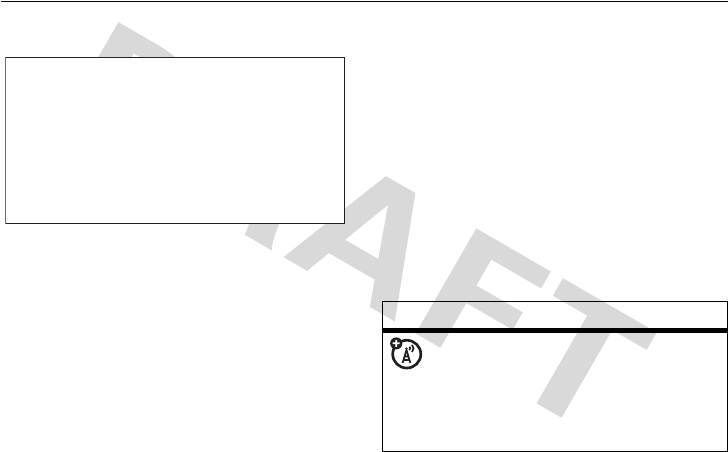
11
essentials
essentials
about this guide
This guide shows how to locate a menu
feature as follows:
Find it:
s
>
sRecent Calls
>
Received
This means that, from the home screen:
1
Press the center key
s
to open
the menu.
2
Press the navigation key
S
to scroll to
sRecent Calls
, and press the center key
s
to select it.
3
Press the navigation key
S
to scroll to
Received Calls
, and press the center key
s
to select it.
CAUTION: Before using the
phone for the first time, read the
Important Safety and Legal
Information
included in the gray-
edged pages at the back of this
guide.
symbols
This means a feature is network/
subscription dependent and may
not be available in all areas. Contact
your service provider for
more information.
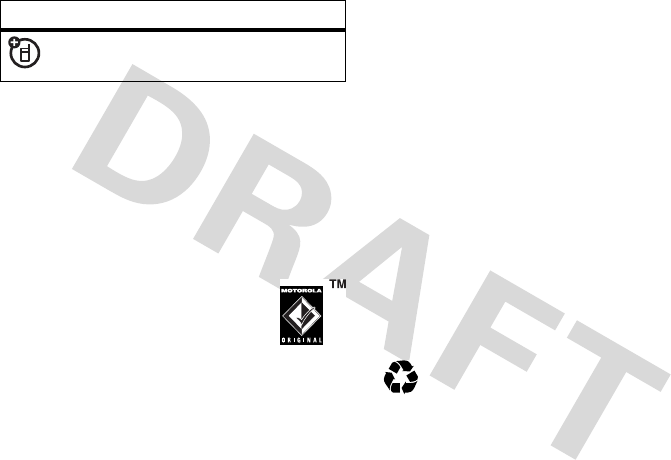
12
essentials
battery
battery tips
Battery life depends on the network, signal
strength, temperature, features, and
accessories you use.
•
Always use Motorola
Original batteries and
chargers. The warranty does
not cover damage caused by
non-Motorola batteries and/
or chargers.
•
New batteries or batteries stored for a
long time may take more time
to charge.
•
When charging your battery, keep it
near room temperature.
When storing your battery, keep it
uncharged in a cool, dark, dry place.
•
Never expose batteries to
temperatures below -10°C (14°F) or
above 45°C (113°F). Always take your
phone with you when you leave
your vehicle.
•
It is normal for batteries to gradually
wear down and require longer charging
times. If you notice a change in your
battery life, it is probably time to
purchase a new battery.
Contact your local recycling center for
proper battery disposal.
Warning:
Never dispose of batteries in a fire
because they may explode.
This means a feature requires an
optional accessory.
symbols
032375o
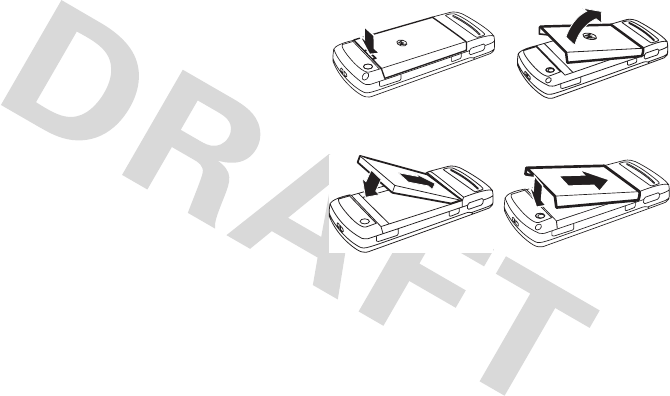
13
essentials
Before using your phone, read the battery
safety information in the “Safety and General
Information” section included in this guide.
To save battery life:
•
Don’t block the light sensor on the
front of your phone (see page 2). The
light sensor helps conserve battery by
sensing when to dim the backlight.
•
Adjust the backlight to turn off more
quickly (see page 40).
•
Turn off Bluetooth power when you are
not using it (see page 55).
install the battery
12
34
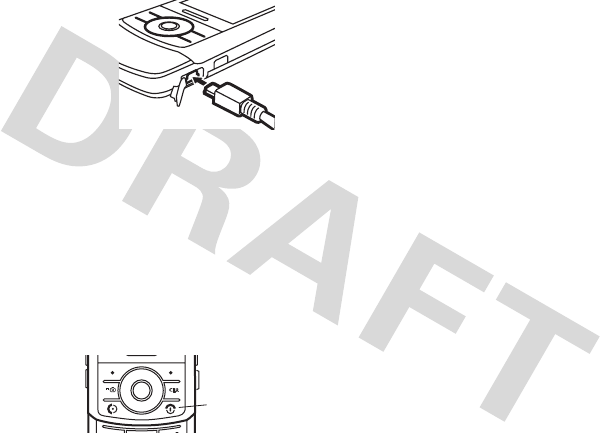
14
essentials
battery charging
New batteries are not
fully charged. Plug the
battery charger into
your phone and an
electrical outlet. Your
phone might take
several seconds to
start charging the battery. The phone shows
Charge Complete
when finished.
Tip:
Relax, you can’t overcharge your battery.
It will perform best after you fully charge and
discharge it a few times.
turn it on & off
To tu r n on yo u r
phone, press and
hold
O
for a few
seconds or until the display turns on.
If prompted, enter your four-digit unlock code.
Your phone’s four-digit
unlock code
is
originally set to
1234
or to the last four digits
of your phone number.
To turn off your phone, press and hold
O
for
two seconds.
lock & unlock slider
You can lock your phone to keep from
accidentally pushing external keys when the
slider is closed.
To lock the phone, push the lock switch
up
(see page 2).
When the phone is
on and locked
, if you
open the slider, the keypad unlocks. When
you close the slider, the phone goes back into
the locked state. When the phone is
off and
J
I
H
G
Power
Key

15
essentials
the locked
, the phone will not turn on, but
briefly displays a white padlock to remind you
that the phone is locked.
make a call
Open your phone
, enter a phone number
and press
N
to make a call.
To “hang up,” close the slider or press
O
.
Tip:
Is your caller saying they can’t hear you?
Make sure your finger is not covering the
microphone (see page 3).
answer a call
When your phone rings and/or vibrates, just
open the slider or press
N
to answer.
To “hang up,” close the slider or press
O
.
adjust volume
With the slider open or closed, press the
volume keys (see page 3) up or down to:
•
increase or decrease earpiece volume
during a call
•
increase or decrease the ringer volume
setting when the home screen is
visible (with the slider open)
•
turn off an incoming call alert
change the call alert
With the slider open or closed, press the
down volume key (see page 3) to switch to
lower call alert volume, then vibrate, and
finally silent alert. Press the up volume key to
cycle back from silent alert to vibrate and then
to the lowest alert volume setting.

16
essentials
store a phone number
You can store a phone number in
Contacts
:
1
Open the slider and enter a phone
number in the home screen.
2
Press
Store
.
3
Enter a name and other details for the
phone number. To select a highlighted
item, press the center key
s
.
4
Press
Done
to store the number.
Note:
To edit or delete a
Contacts
entry, see
page 76.
To store an email address, press
s
>
nContacts
>
[New Entry]
>
Email
. Enter the
name and email address.
call a stored phone
number
Find it:
s
>
nContacts
1
Scroll to the
Contacts
entry.
2
Press
N
to call the entry.
Shortcut:
In
Contacts
, enter the first letters of
an entry you want. You can also press
*
and
#
to see the entries you use
frequently, or entries in other categories.
view your phone
number
Find it:
s
>
wSettings
>
mPhone Status
>
My Tel. Number
Tip:
Want to see your phone number while
you’re on a call? Press
Options
>
My Tel. Number
.
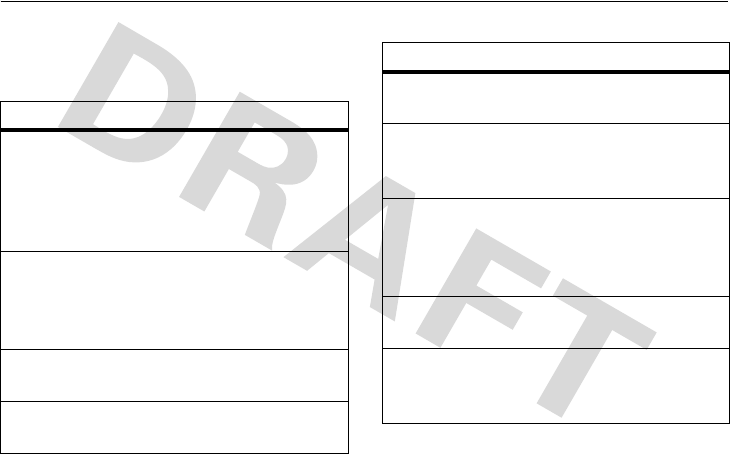
17
tips & tricks
tips & tricks
From the home screen
(page 18), you can
use the following shortcuts:
To... Do this...
Play music
Press the music/camera key
l
or press the Smart/
Speakerphone Key (see
page 3) to open the music
player.
Tu r n
speaker-
phone on
or off
Press and hold the Smart/
Speakerphone Key
(see page 3).
Call
voicemail
Open the slider. Press and
hold
1
.
See recent
calls
Press the send key
N
.
Change
ring style
Press the side volume keys
(see page 3).
Ta k e a
picture
Press and hold the music/
camera key
l
to activate
the camera.
Lock the
slider
external
keys
Push the side lock key up
(see page 3).
Use voice
commands
Press the side voice
command key (see page 3).
Record a
voice note
Press and hold the side
voice command key (see
page 3).
To... Do this...
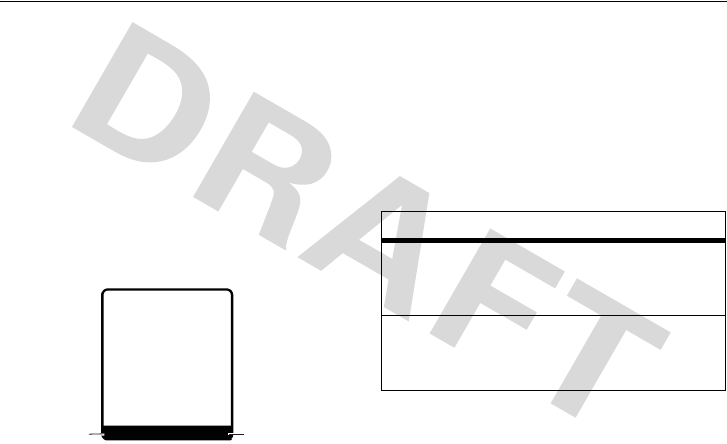
18
basics
basics
See page 2 for a basic phone diagram.
home screen
When you turn on your phone, it displays the
home screen. To dial a number from the
home screen, open the slider, press number
keys and
N
.
Note:
Your home screen might look a little
different from this example.
Soft key labels show the current soft key
functions. For soft key locations, see page 2.
Press the navigation key
S
up, down, left, or
right to select items in the home screen.
Status indicators can appear across the top of
the home screen:
Right Soft Key
Label
Left Soft Key
Label
Recent Messaging
6Îì
WED 10/10/07
10:51am
L
h
J
e
&
&
&
&
indicator
6
Signal
Strength
Vertical bars show the
strength of the network
connection.
W
Roaming
Indicates phone is in a
digital coverage area and
is roaming off network.
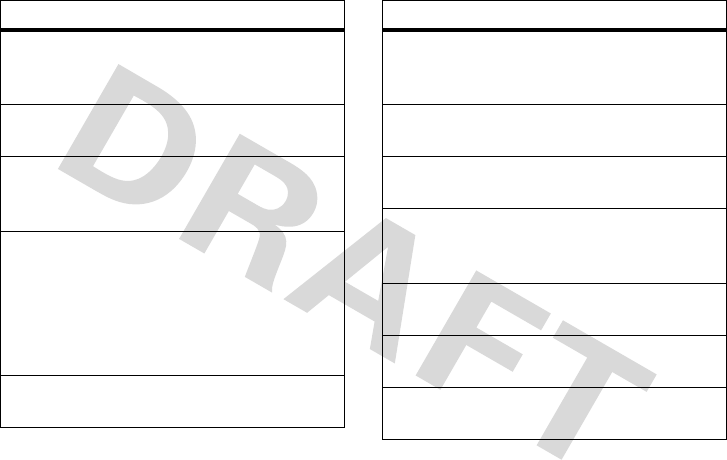
19
basics
/
Digital
Indicates phone is in a
CDMA digital coverage
area.
I
1X
Indicates phone is in a
1x-RTT coverage area.
×
Missed Call
Indicates that you
received an unanswered
call.
+
Data Call,
Te t h e r e d , o r
Embedded
WAP/BREW
Application
Shows during data call,
tethered mode, or WAP/
BREW application.
÷
No Service
Phone is in area with no
service coverage.
indicator
h
Voice Call/
Incoming Call
Shows during an active
voice call.
ë
Location On
Shows when
Location
is
set to
On
.
Keypad Locked
Phone Locked
Shows when phone is
locked.
ì
Battery Level
Shows battery charge
level. The more bars, the
greater the charge.
õ
Sounds Loud
Indicates
Style
(in
Ring
Styles
) is set to
Loud
.
ô
Sounds Soft
Indicates
Style
(in
Ring
Styles
) is set to
Soft
.
Î
All Sounds Off
Indicates
Style
(in
Ring
Styles
) is set to
Silent
.
indicator
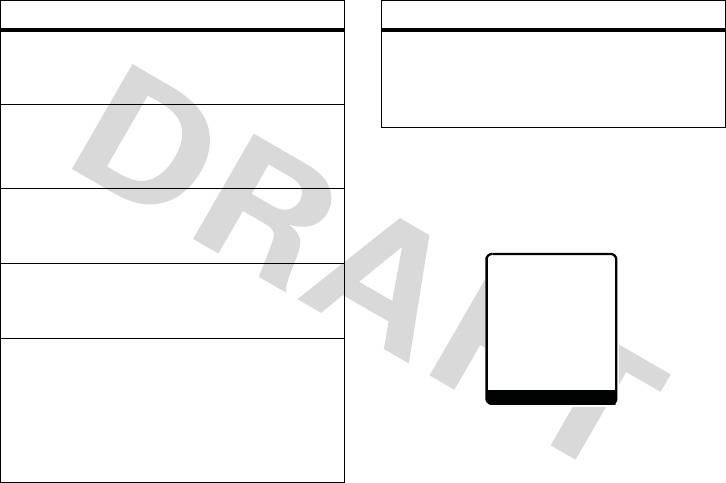
20
basics
shortcuts & main menu
Your phone displays four menu icons in the
middle of the home screen.
Press
S
left, right, up, or down to open the
menu for the corresponding icon.
Ì
Sound On,
Vibrate On
Indicates
Style
(in
Ring
Styles
) is set to
Vibe then
Ring
.
Spkrphone On
Speakerphone
On
Indicates speakerphone
is on.
Q
New Text
Message
Appears when you
receive a new text
message.
t
New Voicemail
Message
Appears when you
receive a new voicemail
message.
0
Airplane Mode
Shows when
Airplane Mode
is turned on. (You cannot
make or answer calls,
but you can use other
non-calling features of
your phone.)
indicator
E
Bluetooth
Connection
Active
Your phone is paired to
another Bluetooth
device.
indicator
Recent Phonebook
6Îì
WED 10/10/07
10:51am
L
h
J
e
&
&
&
&
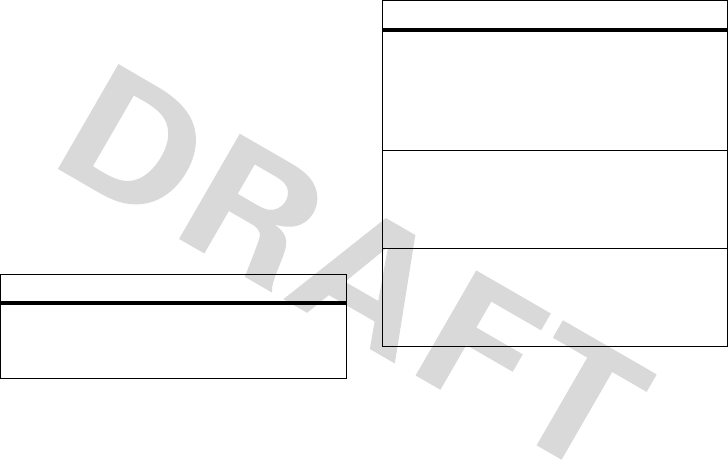
21
basics
home screen shortcuts
You can change the
shortcuts
that open
features when you press the navigation key
and soft keys in the home screen. For key
locations, see page 2.
Note:
This option might be restricted or
unavailable if your home screen shows
scrolling headlines from your service provider.
Find it:
s
>
wSettings
>
Personalize
>
Home Screen
>
Home Keys
main menu appearance
To change your
main menu icons
, press
s
>
wSettings
>
Personalize
>
Home Screen
>
Home Keys
>
Icons
.
options
Icons
Show or hide your
navigation key shortcut
icons in the home screen.
Up
,
Down
,
Left
,
Right
Choose the features that
open when you press the
navigation key up, down,
left, or right in the home
screen.
Left Soft Key
Choose the feature that
opens when you press the
left soft key in the home
screen.
Right Soft Key
Choose the feature that
opens when you press the
right soft key in the home
screen.
options
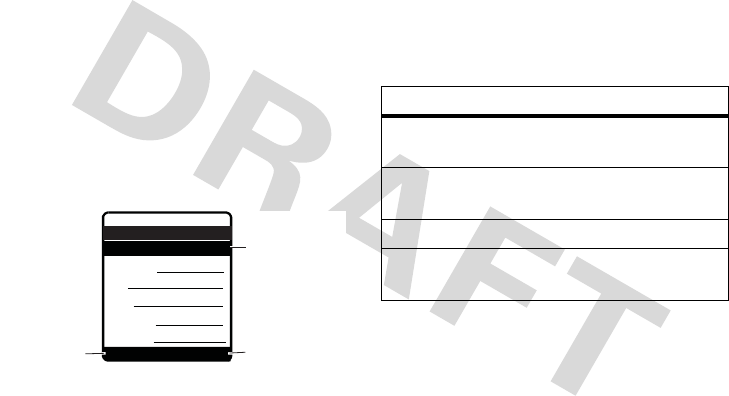
22
basics
To make your
main menu appearance
either
icons or a text-based list, press
s
>
wSettings
>
Personalize
>
Main Menu
>
View
.
For even more ways to personalize your home
screen, see page 83.
enter text
Some screens require you to enter text, such
as when you compose a message or create a
new contact, as this example shows:
Use the keypad to enter text.
set entry modes
Set text entry modes to make it easier for you
to enter names, numbers, and messages.
In a text entry screen, press
*
to switch to
any of these entry modes:
To assign a Primary or Secondary text
entry mode:
1
In any text entry screen, press
Options
.
2
Scroll to
Text Setup
and press
Select
.
6Îì
Entry Details
Name: John Smith
No.: 2125551212
Type: Mobile
Speed No.: 6
Category: General
Ringer ID: None
t
Done Cancel
Press
Done
to save
all changes
.
Press
Cancel
to exit
without
making
changes
.
Highlighted
Option
entry modes
Primary
Enter text using a method that
you set.
Numeric
Enter numbers only (see
page 27).
Symbol
Enter symbols only (see page 27).
Secondary
Enter text using a method that
you set.
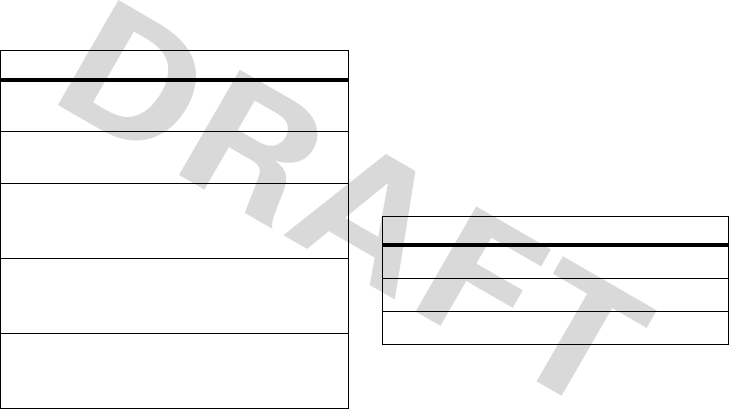
23
basics
3
Scroll to
Primary Setup
or
Secondary Setup
and
press
Change
.
4
Scroll to one of the following choices and
press
Select
:
Note:
Your phone may not contain all of the
languages listed above.
To select a text entry mode:
Press
Options
in any text entry screen, scroll to
and select
Text Setup
, then scroll to and select
the desired entry mode.
capitalization
Press
0
in any text entry screen to change
the text case. The following indicators show
capitalization status:
options
iTAP
English
Let the phone predict each
English word as you press keys.
iTAP
Español
Let the phone predict each
Spanish word as you press keys.
iTAP
Portuguêse
Let the phone predict each
Portuguese word as you
press keys.
Tap
English
Enter letters and numbers by
pressing a key one or more
times.
Tap
Extended
Enter letters, numbers, and
symbols by pressing a key one or
more times.
capitalization status
Á
no capital letters
á
all capital letters
Â
capitalize next letter only
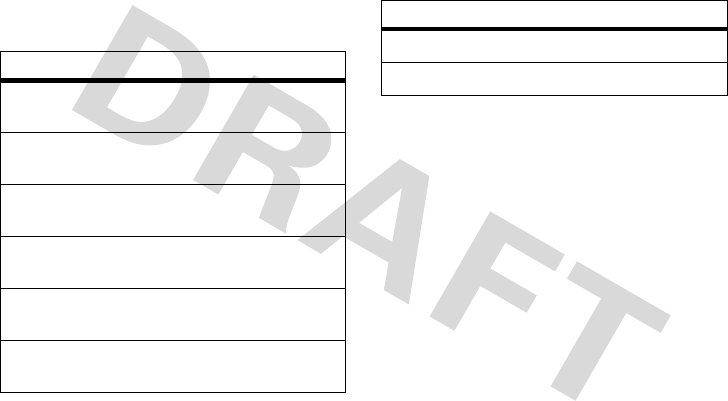
24
basics
text entry mode indicators
When you select the
Primary
or
Secondary
text
entry mode, the following indicators identify
the text entry setting:
The following indicators identify
Numeric
or
Symbol
entry mode:
tap method
This is the standard method for entering text
on your phone.
Regular
Tap
method cycles through the letters
and numbers of the key you press. The
Tap
Extended
method cycles through letters,
numbers,
and
symbols.
1
Press a key one or more times to select a
letter, number, or symbol.
2
Repeat the step above to enter
all characters.
primary secondary
gm
Tap, no capital
letters
hq
Tap, capitalize
next letter only
fl
Tap, all capital
letters
jp
iTAP™, no
capital letters
kn
iTAP
,
capitalize
next letter only
io
iTAP, all capital
letters
non-text entry mode
Ã
numeric mode
Ä
symbol mode

25
basics
Tip:
Press
S
right or
#
to insert a space.
In a text entry screen you can press
*
to
switch entry modes. If
Tap
or
Tap Extended
is not
available as the
Primary
or
Secondary
entry mode,
see page “set entry modes” on page 22.
When you enter three or more characters in a
row, your phone may guess the rest of the
word. For example, if you enter
prog
, you might
see:
If you want a different word, continue
pressing keys to enter the remaining
characters.
•
Press a keypad key repeatedly to cycle
through its characters.
•
Press
S
left or right to move the
flashing cursor to the left or right in a
text message.
•
The first character of every sentence is
capitalized. If necessary, press
S
down to change the character to
lowercase before the cursor moves to
the next position.
•
If you don’t want to save your text or
text edits, press
O
to exit without
saving.
6Îì
436
This is a prog ram
Press
S
right
to accept
Program
, or
press
S
up or
down to reject it.
Press # to enter
a space after
prog
.
ÁÔ Msg
Recent Phonebook
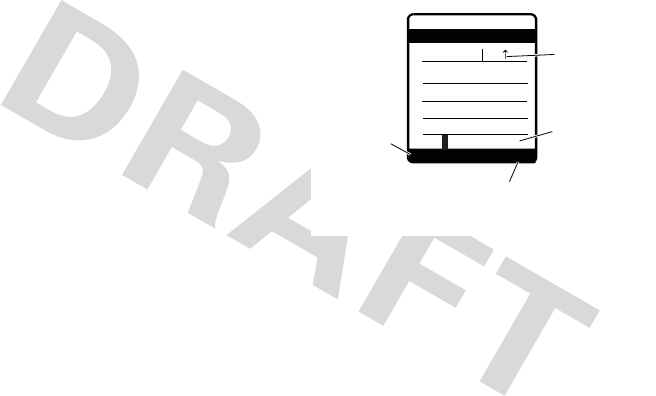
26
basics
iTAP® method
The iTAP software combines your key presses
into common words, and predicts each word
as you enter it. This can be faster than
Tap method.
1
Press keypad keys to show possible letter
combinations at the bottom of the screen.
2
Scroll left or right to highlight the
combination you want.
3
Press
Select
to lock a highlighted
combination.
You can press keys to add more letters to
the end of the combination.
or
Press
*
to enter the highlighted
combination when it spells a word.
A space is inserted after the word.
For example, if you press
7764
, your
phone displays the corresponding
letter combinations:
If you enter a word your phone does not
recognize, your phone stores the word to use
as a future word option. When you run out of
phone memory for unrecognized words, your
phone deletes the oldest word to add
new words.
6Îì
433
ÁÛ Msg
This is a prog ram
Press
S
up
to accept
program
.
prog proh proi pro4
Press
S
right
to select
another
combination.
Press
Delete
to delete
last letter.
Press
Select
to lock
highlighted
combination.
Select Delete

27
basics
numeric method
In a text entry screen, press
*
to switch
entry methods until your phone displays the
Ã
(numeric) indicator.
Press keypad keys to enter the numbers you
want. When you finish entering numbers,
press
*
to switch to another entry method.
symbol method
In a text entry screen, press
*
to switch
entry methods until your phone displays the
Ä
(numeric) indicator.
1
Press a key one or more times to show
possible symbol combinations at the
bottom of the screen.
2
Scroll left or right to highlight the symbol
you want.
3
Press
Select
to enter the
highlighted symbol.
delete letters & words
Place the cursor to the right of the text you
want to delete and then:
•
Press
B
to delete one letter at a time.
• Press and hold
B
to delete the
entire message.
slider closed
With your phone closed, you can use
any
feature that doesn’t require the keypad
:
•
answering calls
•
viewing message notifications
•
calling people in your contacts
•
sending text or MMS templates to
people on your contacts list
•
taking pictures or videos

28
basics
•
playing music
•
setting phone alert styles
To set the phone alert style with slider
closed
:
1
Press the volume keys up or down to
scroll through styles.
2
Press the smart/speakerphone key to
select the displayed style.
3
Press the volume keys up or down to
return to the home screen.
To view an unanswered call when you see
X Missed Calls
:
1
Press the smart/speakerphone key to
view the received calls list.
2
Press the volume keys up or down to
scroll through and select a call.
3
Press the smart/speakerphone key to
view the selected call.
continue or end task
when closing slider
You can set your phone to either end or
continue a task when you close the slider. For
example, if you want to be able to close your
slider during a phone call without hanging up,
set the
Slide Closed
option to
Continue Task
.
Find it:
s
>
wSettings
>
InitialSetup
>
Slide Closed
Note:
When you set your slider to
End Task
, all
tasks end
except
calls while you’re using
Bluetooth, wired headset, or the
speakerphone. If you are downloading any
applications, closing the slider doesn’t
interrupt the download. If the download hasn’t
started yet, closing the slider stops
the download.

29
basics
handsfree speaker
Note:
The slider does not have to be open to
use the speakerphone.
You can use your phone’s handsfree speaker
to make calls without holding the phone to
your ear.
Note:
The handsfree speaker won’t work
when your phone is connected to a handsfree
car kit or headset.
To activate the
speakerphone
during a call, press
and hold the smart/
speakerphone key.
You will see
Spkrphone On
and
hear an audio alert.
To end the call
, press
End Call
or press
O
.
Note:
Closing the slider while using the
speakerphone does not end the call.
To deactivate the speakerphone
, press and
hold the smart/speakerphone key again or
turn off the phone. You will see
Speakerphone Off
.
You can also set your phone to turn off the
speakerphone automatically after 20 seconds
of inactivity:
Find it:
s
>
wSettings
>
InitialSetup
1
Scroll to
SpeakerPhone
and press
Change
.
2
Scroll to
20 sec timeout
and press
Select
.
To use the speakerphone with your
phone’s slider closed
:
1
Open the slider.
2
Press and hold the smart/speakerphone
key to turn on the speakerphone.
3
Enter the number you want to call and
press
N
.
Volume
Keys
Smart/
Speaker-
phone
Key
J
I
H
G

30
basics
4
When the call connects, close the slider
and continue your conversation.
5
To end the call, press and hold the smart/
speakerphone key. You will see
Call Ended
and hear a soft audio alert.
codes & passwords
Your phone’s four-digit
unlock code
is
originally set to
1234
or to the last four digits
of your phone number. The six-digit
security
code
is originally set to
000000
. Your service
provider may reset these codes before you
get your phone.
If your service provider didn’t change these
codes, you should change them to prevent
others from accessing your personal
information. The unlock code must contain
four digits. The security code must contain
six digits.
To change a code or password
:
Find it:
s
>
wSettings
>
Security
>
New Passwords
If you forget your unlock code:
At the
Enter Unlock Code
prompt, try entering 1234 or the
last four digits of your phone number. If that
doesn’t work, contact your service provider.
If you forget your security code
, contact
your service provider.
lock & unlock phone
You can lock your phone to keep others from
using it. To lock or unlock your phone, you
need the four-digit unlock code.
Note:
You can make emergency calls on a
locked phone (see page 47). A locked phone
still rings or vibrates for incoming calls or

31
basics
messages,
but you need to unlock it
to answer
.
To lock your phone
:
Find it:
Press
s
>
wSettings
>
Security
>
Phone Lock
>
Lock Now
or
Automatic Lock
Enter the four-digit unlock code, then press
Ok
.
To unlock your phone
:
When you see
Enter Unlock Code
, enter your
four-digit unlock code and press
Ok
.
airplane mode
Note:
Consult airline staff about the use of
Airplane Mode
during flight. Turn off your phone
whenever instructed to do so by airline staff.
Airplane mode turns off your phone’s calling
features in situations where wireless phone
use is prohibited. You can use the phone’s
other non-calling features when
Airplane Mode
is
turned on.
Find it:
sÉTools
>
Airplane Mode
>
On
or
Off
Your phone can prompt you to activate or
deactivate each time you turn on the phone:
Find it:
sÉTools
>
Airplane Mode
>
Prompt At Startup
>
On
or
Off
memory card
You can store multimedia content such as
songs and photos on your phone’s internal
memory or on a removable microSD
(TransFlash) memory card.
Notes:
•
If you download a copyrighted file and
store it on your memory card, you can
use the file only when your memory
card is inserted in your phone. You
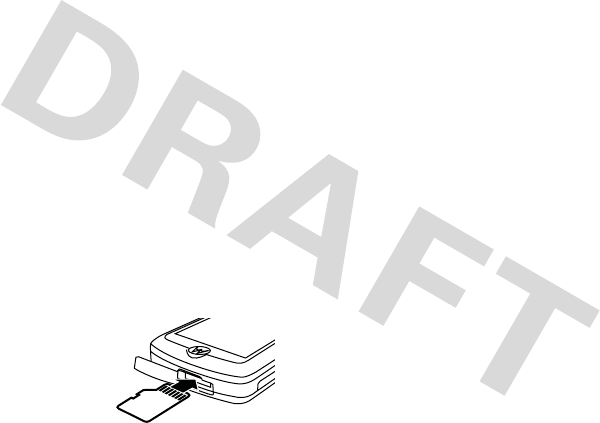
32
basics
cannot send, copy, or change
copyrighted files.
•
If you don’t have a memory card, you
can copy files from your computer to
your phone via Bluetooth (page 55) or
by using Motorola Phone Tools
(page 60).
•
Your phone supports microSD memory
cards with up to 2 GB capacity (greater
than 1 GB capacity is guaranteed only
for SanDisk microSD cards).
install memory card
1
Open the memory card slot cover on the
top of your phone (see page 3).
2
Slide the memory
card into the card
slot until it clicks.
3
Replace the memory card slot cover.
To remove the card, press it once quickly to
release it from the slot, and then pull it out.
Do not remove your memory card while your
phone is using it or writing files on it.
format memory card
Note:
You must format a memory card before
using it for the first time. This procedure is
critical because it creates the “Mobile” and
“Motorola” directories. If you do not format a
memory card before using it for the first time,
your phone may not be able to read the
contents of the card.
Caution:
Formatting the memory card will
erase all content currently stored on the card.
Find it:
Press
s
>
mPhone Status
>
Storage Devices
Find it:
{

33
basics
1
Scroll to
Memory Card-T-Flash
and press
Options
.
2
Scroll to
Format
and press
Select
.
3
When prompted, press
Yes
to continue or
No
to cancel formatting.
view memory card contents
Find it:
Press
shMedia Gallery
1
Select the desired multimedia object type
(
Pictures
,
Sounds
, or
Videos
).
2
Press
Options
to open the menu for the
selected object type.
3
Scroll to
View Storage Devices
and press
Select
.
4
Scroll to
All
(to view contents of the
memory card and phone memory),
Phone
Memory
, or
Memory Card
, and press the
center key
s
.
copy or move files between
phone & memory card
You can copy or move files (such as photos or
music files) from your phone to the memory
card to free up phone memory.
Note:
Moving a file to the memory card
deletes the original file from phone memory.
Find it:
Press
shMedia Gallery
1
Scroll to
Pictures
,
Sounds
, or
Videos
and press
Select
.
Note:
Pictures that came preloaded on
your phone cannot be moved to the
memory card.
2
Scroll to the picture or video clip you want
to move or copy and press
Options
.
3
Scroll to
Mark
and press
S
right.
4
Scroll to
Current
(to mark the selected file)
or
All
(to mark all files) and press
Select
.

34
basics
5
Press
Options
, then scroll to
Manage Marked
Files
and press
S
right.
6
Scroll to
Copy
or
Move
and press
Select
.
7
Scroll to the device where you want to
copy or move the file and press the
center key
s
.
transfer files from computer to
memory card
To transfer files from a computer to your
phone’s memory card, you can use either a
Bluetooth connection, cable connection, or a
card reader.
For details about Bluetooth connections, see
page 55. Memory cards, USB cables, and
card readers are not included with your
phone, but you can buy them separately.
Note: You must format your memory card
before you use it for the first time (see
page 32).
To use a USB cable connection
1
Disconnect the cable from your phone if
it’s already connected.
2
On your phone, press
s
>
wSettings
>
Connection
>
USB Settings
.
3
With
Default
highlighted, press
Change
.
4
Scroll to
USB Drive
and press
Select
.
5
Press
O
to return to the home screen.
6
Connect the cable to your phone and to an
available USB port on your computer.
Note:
When your phone is connected to a
computer, you cannot access the memory
card through the phone. For more details
about cable connections, see page 58.

35
basics
7 On your computer
, open your “My
Computer” window, where your phone’s
memory card displays as a “Removable
Disk” icon.
8
Click on the “Removable Disk” icon to
access your phone’s memory card.
9
In the “Removable Disk” (memory card)
window, create one or more folders for
the files you will copy onto the
memory card.
You can save up to 50 files in each folder
that you create. When the music player
looks for music files on the card, it will
search all folders on the card if the
Search
option is set to
Always
or
Ask
(see page 68).
A file name (including the path) must be
less than 241 characters. For example, if
you copy songs into a folder you create
that is named “MyMotoSongs,” the name
of any song PLUS the name of the folder
“MyMotoSongs” must be less than 241
characters.
Note:
You may see “Mobile” and
“Motorola” folders in the memory card
window. These folders are used by your
phone.
Do not delete these folders
.
10
Copy desired files onto the memory card
by dragging and dropping them into the
“Removable Disk” window,
into a folder
that you have created
.
Do not copy files
to the main directory
.
11
When you finish, disconnect your phone
by clicking on the “Safely Remove
Hardware” icon in the system tray on your
computer screen, then selecting “Safely
Remove USB Mass Storage Device.”
12
Disconnect the cable from your phone
and computer.

36
basics
To use a memory card reader
1
Insert your memory card into the card
reader.
Note:
You may first need to insert the
card into an adapter that fits into the
card reader.
2
Insert the card reader into an available
USB port on your computer.
3
Open your “My Computer” window on
your computer, where your phone’s
memory card shows as a “Removable
Disk” icon.
4
Click on the “Removable Disk” icon to
access your phone’s memory card.
5
In the “Removable Disk” (memory card)
window, create one or more folders for
the files you will copy onto the
memory card.
You can save up to 50 files in each folder
that you create. When the music player
looks for music files on the card, it will
search all folders on the card if the
Search
option is set to
Always
or
Ask
(see page 68).
A file name (including the path) must be
less than 241 characters. For example, if
you copy songs into a folder you create
that is named “MyMotoSongs,” the name
of any song PLUS the name of the folder
“MyMotoSongs” must be less than 241
characters.
Note:
You may see “Mobile” and
“Motorola” folders in the memory card
window. These folders are used by your
phone.
Do not delete these folders
.
6
Copy desired files onto the memory card
by dragging and dropping them into the
“Removable Disk” window,
into a folder
that you have created
.

37
basics
Do not copy files to the main directory
(where the “Mobile” and “Motorola”
folders are located).
7
When you finish, disconnect the card
reader by clicking on the “Safely Remove
Hardware” icon in the system tray on your
computer screen, then selecting “Safely
Remove USB Mass Storage Device.”
8
Remove the card reader from
the computer.
9
If necessary, remove the memory card
from the adapter.
10
Insert the memory card into your phone
(see page 31).

38
customize
customize
ring styles & alerts
Your phone rings and/or vibrates to notify you
of an incoming call or to signal certain other
events. This ring or vibration is called an alert.
set a style
Find it:
s
>
wSettings
>
Ring Styles
1
Scroll to
Style
and press
Change
or the center
key
s
.
2
Scroll to the desired ring style and press
Select
or the center key
s
.
set alerts
Your phone includes alerts for
Calls
,
Inbox
,
Voicemail
,
Alarms
,
Data Calls
,
Fax Calls
, and
Reminders
.
You can specify a detailed setting for each
type of alert:
Find it:
s
>
wSettings
>
Ring Styles
1
Scroll to Style
Detail
and press
Change
or the
center key
s
.
2
Scroll to the desired alert type and press
Change
or the center key
s
.

39
customize
3
Scroll to the desired detail setting and
press
Select
or the center key
s
.
Note:
Your phone plays a sample of each
highlighted setting as you scroll through
the settings.
wallpaper
Set a photo, picture, or animation as a
wallpaper (background) image in your
home screen.
Note:
Yo u r theme can set your wallpaper
(page 40).
s
>
wSettings
>
Personalize
>
Wallpaper
To select a wallpaper image
:
1
Scroll to
Picture
and press
Change
or the
center key
s
.
2
Scroll to the picture you want and press
the center key
s
.
Select
(None)
to turn off wallpaper.
To adjust wallpaper image layout
:
1
Scroll to
Layout
and press
Change
or the
center key
s
.
2
Scroll to
Center
,
Tile
, or
Fit-to-screen
, and press
Select
or the center key
s
.
To set a monthly calendar as your
wallpaper
:
1
Scroll to
Calendar
and press
Change
or the
center key
s
.
2
Scroll to
On
and press
Select
or the center
key
s
.

40
customize
set screen saver
Set a photo or picture as a screen saver
image.
The screen saver image appears when the
slider is open and no activity is detected for a
specified time period. The image shrinks to fill
the display, if necessary.
Tip:
Turn off the screen saver to extend
battery life.
Find it:
s
>
wSettings
>
Personalize
>
Screen Saver
To select a picture to use as a screen saver
:
1
Scroll to
Picture
and press
Change
or the
center key
s
to view available pictures.
2
Scroll to the picture you want and press
Select
or the center key
s
.
Select
(None)
to turn off the screen saver.
To specify how long your phone must be
inactive before it displays the screen saver
:
1
Scroll to
Delay
and press
Change
.
2
Scroll to
1 minute
,
2 minutes
,
5 minutes
, or
10
minutes
, and press
Select
.
brightness
Find it:
s
>
wSettings
>
InitialSetup
>
Brightness
Use the left and right navigation keys to adjust
the brightness.
backlight
Set the amount of time that the display
and keypad backlights remain on, or turn
off backlights to extend battery life.
Find it:
s
>
wSettings
>
InitialSetup
>
Backlight

41
customize
talking phone settings
You can set your phone to speak aloud the
name of a Contacts entry when you highlight
that entry in the phonebook. You can also set
it to speak the names of digits as you enter a
number to call.
To s e t u p
the talking phone feature:
Find it:
s
>
wSettings
>
Personalize
>
Sound Settings
>
Talking Phone Settings
Select
Contact List Entries
or
Keypad Digits
and press
Change
, then select
On
or
Off
.
To a c t i va t e
the talking phone feature:
Find it:
s
>
wSettings
>
Personalize
>
Sound Settings
>
Talking Phone
>
On
AGPS & your location
Note:
This Motorola mobile phone
incorporates Assisted Global Positioning
System (AGPS) technology that can be used
by emergency services to help determine a
user’s location. This functionality is required
by law and cannot be deactivated. However,
AGPS technology also can be used with
certain location-based software
applications—for example, to provide driving
directions—which may track and monitor a
user’s location. Users who prefer not to
permit such tracking and monitoring should
avoid using such applications.
Your phone uses the Automatic Location
Information (ALI) feature, along with AGPS
satellite signals, to tell the network where you
are physically located.

42
customize
Note:
ALI may not work in all locations and
may not be available due to network,
environmental, or interference issues.
When ALI is set to
Location
>
On
, your phone
shows the
O
(ALI on) indicator. Services
may use your known location to provide
useful information (for example, driving
directions, or the location of the nearest
bank). Your phone prompts you when the
network or a service asks for your location.
You can refuse at this point.
When ALI is set to
Location
>
Off
, your phone
displays the
P
(ALI off) indicator, and the
phone does not send location information
unless you call the emergency phone number
(such as 911).
Find it:
s
>
wSettings
>
Location
>
On
or
Off
To view or change the location transmission
status of your phone during a call, press
s
>
Location
.
AGPS limitations & tips
Your phone uses Assisted Global
Positioning System (AGPS) satellite
signals to estimate your location. If your
phone cannot find strong satellite signals,
your AGPS might be slower, less accurate, or
it might not work at all. AGPS provides only an
approximate location, often within 150 feet
(45 meters) but sometimes much farther from
your actual location.
To improve AGPS accuracy:
•
Go outside and away from
underground locations, covered
vehicles, structures with metal or
concrete roofs, tall buildings, and
foliage. Indoor performance might
improve if you move closer to
windows, but some window sun

43
customize
shielding films can block satellite
signals.
•
Move away from radios, entertainment
equipment, and other electronic
devices that might interfere with or
block AGPS satellite signals.
•
Hold your phone away from your body,
and point the phone antenna toward
the sky. Do not cover the antenna area
with your fingers
AGPS uses satellites controlled by the U.S.
government and subject to changes
implemented in accordance with the
Department of Defense AGPS user policy and
the Federal Radio Navigation Plan. These
changes might affect AGPS performance.

44
calls
calls
To make and answer calls, see page 15.
turn off a call alert
You can press the volume keys to turn off a
call alert before answering the call.
redial a number
1
Press
N
from the home screen.
2
Scroll to the entry you want to call and
press
N
.
automatic redial
When you receive a
busy signal
, your
phone displays
Call Failed, Number Busy
.
When you set
Auto Redial
to
On
, your phone
automatically redials a busy number for four
minutes. When the call connects, your phone
rings or vibrates once, displays
Redial Successful
,
and completes the call.
Find it:
s
>
wSettings
>
InitialSetup
>
Auto Redial
When automatic redial is turned off, you can
manually activate the feature to redial a phone
number. When you hear a fast busy signal and
see
Call Failed
, press
N
or
RETRY
.
recent calls
Your phone keeps lists of the calls you
recently received and dialed, even if the calls
didn’t connect. The lists are sorted from
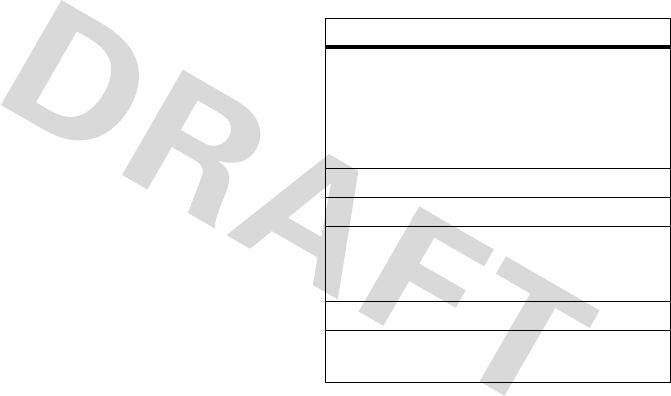
45
calls
newest to oldest calls. The oldest calls are
deleted as new calls are added.
Tip:
Press
N
from the home screen to view
the dialed calls list.
Find it:
s
>
sRecent Calls
1
Scroll to
Received Calls
or
Dialed Calls
and press
Select
.
2
Scroll to an entry.
Note:
A
%
next to a call means the call
connected.
3
Press
N
to call the number.
To see call details (like time and date),
press the center key
s
.
To access a menu of options (see the
table following these steps), press
Options
.
When you press
Options
while viewing a list of
recent calls, you see a menu that can include
these options:
option
Store
Create a Contacts entry
with the number in the
Number
field.
Store
does not
appear if the number is
already in your Contacts.
Delete
Delete the entry.
Delete All
Delete all entries in the list.
Send Message
Open a new text message
with the number in the
To
field.
Add Digits
Add digits after the number.
Attach Number
Attach a number from the
Contacts
or recent calls lists.

46
calls
return a missed call
Your phone keeps a record of your
unanswered calls, and shows
X Missed Calls
,
where
X
is the number of missed calls.
1
Press the
View
key to see the
Received
Calls
list.
2
Scroll to the call you want to return, then
press
N
.
answer options
You can change how you answer a call:
Find it:
s
>
wSettings
>
In-Call Setup
>
Answer Options
notepad
The most recent set of digits that you enter
are stored in your phone’s notepad memory.
To retrieve a number stored in the notepad
:
Find it:
s
>
É
Recent Calls
>
Notepad
Press
N
to call the number.
Press
Options
to open the
Options
menu to attach
a number or insert a special character.
Press
Store
to create a Contacts entry with the
number in the
Number
field.
attach number
While dialing (with digits visible on the
screen), press
s
>
Attach Number
to attach a
number from the phone book or a recent
calls list.
Multi-Key
Answer by pressing any key.
Open To Answer
Answer by opening the
slider.

47
calls
emergency calls
Your service provider programs emergency
phone numbers, such as 911 or 112, that you
can call under any circumstances, even when
your phone is locked.
1
Enter the emergency number.
2
Press
N
.
Note:
Emergency numbers vary by country.
Your phone’s preprogrammed emergency
number(s) may not work in all locations, and
sometimes an emergency call cannot be
placed due to network, environmental, or
interference issues.
AGPS during an
emergency call
When you make an emergency call,
your phone can use Assisted Global
Positioning System (AGPS) satellite signals to
tell the emergency response center your
approximate location.
The AGPS feature has limitations, so always
tell the emergency response center your best
knowledge of your location. Remain on the
phone for as long as the emergency response
center instructs you.
AGPS
might not work
for emergency calls:
•
Your phone’s AGPS feature must be
turned on (see page 41).
•
Your local emergency response center
might not process AGPS location

48
calls
information. For details, contact your
local authorities.
For best results:
•
Go outside and away from
underground locations, covered
vehicles, structures with metal or
concrete roofs, tall buildings, and
foliage. Indoor performance might
improve if you move closer to
windows, but some window sun
shielding films can block satellite
signals.
•
Move away from radios, entertainment
equipment, and other electronic
devices that might interfere with or
block AGPS satellite signals.
If your phone cannot find strong AGPS
satellite signals, the location of the nearest
cell tower in contact with your phone is
automatically provided to the emergency
response center.
speed dial
You can assign a unique speed dial number to
each entry in your Contacts.
Note:
Your service provider may have already
assigned speed dial number 1 to your voice
mail number.
To speed dial a number:
1
Enter the speed dial number for the entry
you want to call and press
#
.
2
Press
N
to call the number.
To assign speed dial numbers to contacts, see
page 77.

49
calls
voicemail
Your network stores the voicemail
messages you receive. To listen to your
messages, call your voicemail number.
Note:
Your service provider may include
additional information about using
this feature.
When you
receive
a voicemail message, your
phone shows a voicemail message indicator
and
New Voicemail
. Press
Call
to listen to the
message.
To
check
voicemail messages:
Find it:
s
>
eMessaging
>
Voicemail
>
Call
Tip:
Use the shortcut to dial voicemail by
pressing and holding
1
.

50
messages
messages
send a multimedia
message
A multimedia message contains embedded
media objects (including photos, pictures,
animations, sounds, and voice records). You
can send a multimedia message to other
wireless phones with multimedia messaging
capabilities and to email addresses.
create & send message
Find it:
s
>
eMessaging
>
Create Message
1
Enter message text.
2
Press
Options
to view MMS
message options.
Note:
See “mms message options” on
page 52 for descriptions of all
menu options.
3
Scroll to
Insert
and press
Select
.
4
To insert a stored multimedia object, scroll
to
Picture
,
New Picture
,
Voice Record
,
Sound
,
Video,
New Video
, and
Text Template
, and press
Select
.
Then scroll to the desired object and
press
Insert
.
or
To take and insert a new photo, scroll to
New Picture
and press
Select
. Then take the
photo and press
Insert
.
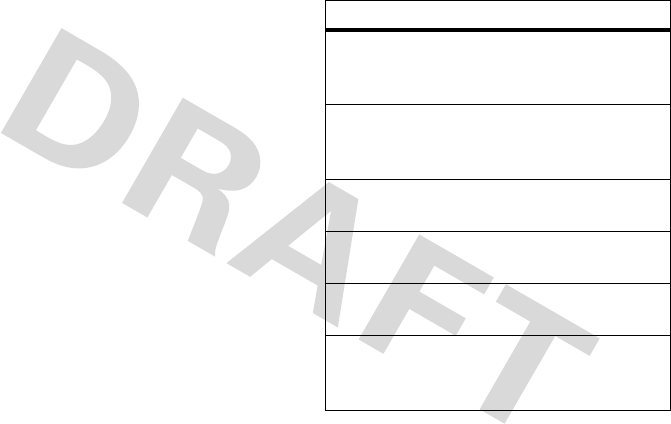
51
messages
or
To record and insert a new video clip,
scroll to
New Video
and press
Select
. Then
record the video clip and press
Insert
.
5
Press
Send To
.
6
Select an entry.
or
Press
Options
to enter the recipient’s
phone number or email address. Press
Ok
when finished.
Note:
You can send the message after
entering a recipient phone number or
email address and the message text. You
do not need to complete the other
entry fields.
7
Press
SEND
to send the message.
or
Press
Options
to see these choices:
Send To options
Unselect All
Unselect all recipient phone
numbers and/or email
addresses.
View Selected
See a list of all recipient
phone numbers and/or
email addresses.
Back to Message
Return to the message text
entry screen.
Enter Number
Enter a recipient phone
number.
Enter Email
Enter a recipient email
address.
Change to MMS
Change a text-only message
type to a multimedia
message.
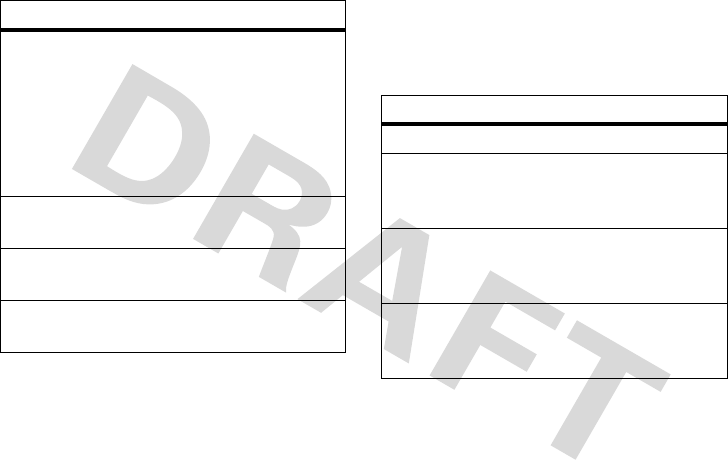
52
messages
mms message options
While creating a multimedia message, press
Options
to open the
MMS Menu
:
Sending Options
Copy other recipients, enter
a message subject, add
attachments, set message
priority, request a message
delivery report, or specify
when to deliver
the message.
Message Details
View detailed information
about the message.
Save to Drafts
Save the message to the
Drafts
folder.
Cancel Message
Cancel the message and
return to the
Message Center
.
Send To options
mms message options
Insert
Insert a multimedia object.
Change to SMS
Change a multimedia
message type to a text
message.
Preview
See the message and see or
listen to inserted multimedia
objects.
Page Options
Specify how long each
multimedia object is
displayed.
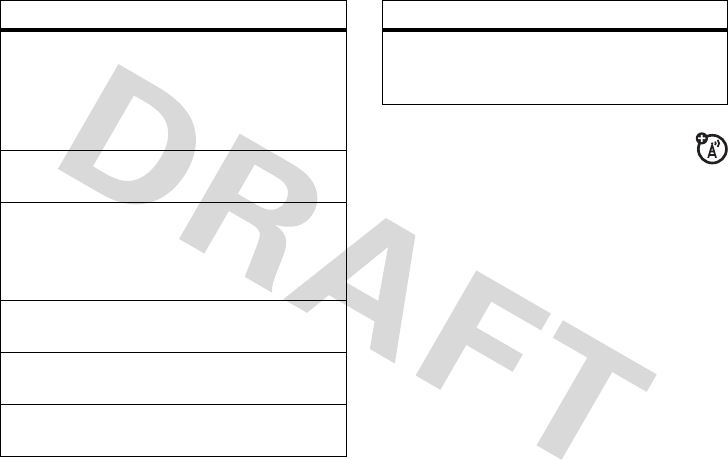
53
messages
receive a multimedia
message
When you receive a multimedia message,
your phone plays an alert and displays the
<
(message waiting) indicator and a
New Message
notification.
Open the slider and press
Read
to read the
message immediately, or save it in your
Message Inbox
for viewing later.
To read messages in your
Message Inbox
:
Find it:
s
>
eMessaging
>
Message Inbox
1
Scroll to the message you want to read.
Sending Options
Copy other recipients, enter
a message subject, add
attachments, set message
priority, or request a
message delivery report.
Message Details
View detailed information
about the message.
Save as Template
Save the message as a text
message template or MMS
message template (see
page 79).
Cancel Message
Cancel the message and
return to the
Message Center
.
Editing Options
Select
Copy Text
,
Cut Text
, or
Copy All Text
.
Change Text
Mode #
Select a text entry mode (for
details, see page 22).
mms message options
Text Setup
Specify default primary and
secondary entry modes (for
details, see page 22).
mms message options

54
messages
2
Press the center key
s
to open the
message. Your phone displays the media
object, then the message.
Multimedia messages can contain different
media objects:
•
Photos, pictures, and animations are
displayed when you read the message.
•
A sound file begins playing when the
message text is displayed. Use the
volume keys to adjust the volume.
Note:
You may have to select an
indicator embedded in the message
text to play a sound file.
If the message includes an attached file
,
select the file indicator or filename and press
View
(for an image file),
Play
(for a sound file), or
Open
(for an object such as a
Contacts
or
datebook entry or an unknown file type).
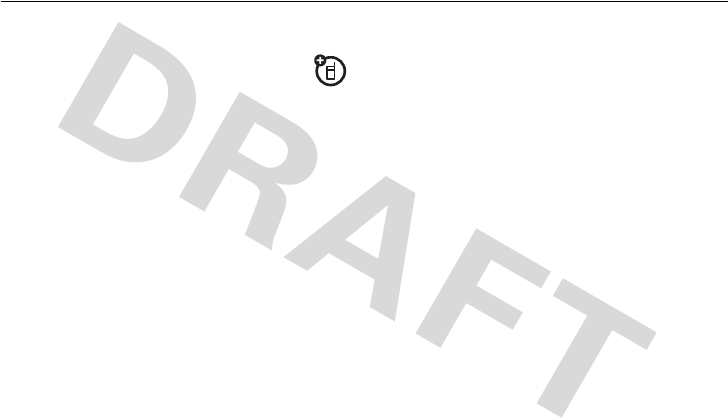
55
connections
connections
Bluetooth®
connections
Your phone supports Bluetooth wireless
connections. You can connect your phone to a
Bluetooth headset or car kit, or connect to
another device to transfer files.
Your phone currently supports the following
Bluetooth profiles:
•
headset (optional Motorola Original™
accessory)
•
Handsfree Car Kit (optional Motorola
Original accessory)
For more Bluetooth wireless connections
support, go to
www.motorola.com/
Bluetoothsupport
.
Note:
All multimedia (video player, audio
player, shutter tones) will play from the
speakerphone when your phone is connected
to another Bluetooth device.
turn Bluetooth power on/off
You can set Bluetooth power to be on
whenever your phone is on.
Find it:
s
>
wSettings
>
Connection
>
Bluetooth Link
>
Setup
1
Scroll to
Power
and press
Change
.
2
Scroll to
On
and press
Select
.

56
connections
Note:
To extend battery life, use the above
procedure and set Bluetooth power to
Off
when not in use. If you turn Bluetooth power
Off
, your phone will not connect to accessories
until you turn Bluetooth power
On
and
reconnect to the accessories.
pair with headset, handsfree
device, or computer
Before you try to connect to another
Bluetooth device
, make sure your phone’s
Bluetooth power is
On
and the device is in
pairing mode (see the user guide for the
device you are attempting to pair with). You
cannot perform pairing while your phone is
connected to another device.
To pair your phone to a headset accessory,
handsfree car kit, or computer that
supports Bluetooth wireless connections:
Find it:
s
>
wSettings
>
Connection
>
Bluetooth Link
>
Audio Devices
>
[Look For Devices]
Your phone displays a list of device(s) within
range of the phone. If your phone is already
connected to a device, your phone lists that
device with a
%
(in-use indicator). After your
phone connects with a device, no other
device can connect to your phone until you
disconnect the current device.
1
Scroll to a device in the list of devices your
phone found.
2
Press the center key
s
to connect
the device.
3
If the device requests permission to bond
with your phone, select
YES
and enter the
device PIN code to create a secure
connection with the device.
Note:
The default PIN code is 0000.

57
connections
When the connection is made, the
à
(Bluetooth) indicator or a
Bluetooth
message
displays in the home screen.
If you are connecting to a computer, use the
Bluetooth wizard or online help to determine
what services are available.
Tip:
For details about an accessory, refer to
the instructions that came with it.
connect with another phone
You can use Bluetooth to connect directly
with another phone.
To transfer a contact from one phone to
another phone
:
1 On the destination phone
, turn on
Bluetooth and then press
s
>
wSettings
>
Connection
>
Bluetooth Link
>
Find Me
.
2 On the origin phone
, open the
phonebook by pressing
s
>
nContacts
.
3
Highlight the entry you want to transfer
and press
Options
.
4
Select
Send Contact
>
Bluetooth
.
Note:
If the origin phone does not already
have Bluetooth power turned on, it prompts
you to turn it on.
5
Select
[Look for Devices]
and select the
destination phone.
When the origin phone connects with the
destination phone, it transfers the entry.
To transfer a file from one phone to
another phone
:
1 On the destination phone
, turn on
Bluetooth and press
s
>
wSettings
>
Connection
>
Bluetooth Link
>
Find Me
.
2 On the origin phone
, select the file you
want to transfer by pressing
s
>
hMedia Gallery
>
Videos
,
Sounds
,
or
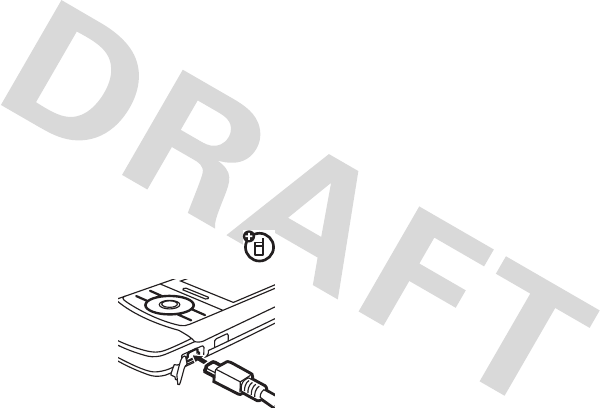
58
connections
Pictures
, highlighting the file, and
pressing
Options
.
3
Select either
Copy
or
Move
.
Note:
If the origin phone does not already
have Bluetooth power turned on, it
prompts you to turn it on.
4
Select
[Look for Devices]
and select the
destination phone.
When the origin phone connects with the
destination phone, it transfers the file.
cable connections
You can use your
phone’s mini-USB port
to connect to
a computer.
Note:
Motorola
Original™ USB data
cables and supporting software may be sold
separately. Check your computer to
determine which cable you need.
If you use a USB cable connection:
•
Be sure to connect the phone to a
high-power USB port
on your
computer
(not a low-power one such
as the USB port on your keyboard or
bus-powered USB hub).
Note:
If you connect your phone to a
low-power USB port, the computer
may not recognize your phone.
•
Make sure both your phone and the
computer are turned on.

59
entertainment
entertainment
Have fun with your phone!
music player
Use your phone’s music player to
play MP3
music files
. You can copy MP3 files on to
your phone or on to an optional memory card
(see page 31).
Note:
Your phone can play MP3, AAC, AAC+,
WMA, M4A, and MP4 files. To play music
files in formats other than MP3 use the
Sounds
option of the
Media Gallery
menu (see page 93).
However, the
Sounds
option doesn’t have all of
the music player capabilities.
Some wireless providers offer music
that you can buy and download from a
Web site. Contact your wireless provider for
more information.
transfer songs
You can load music directly on to your phone
or on to a removable memory card. If you
don’t have a memory card, the music player
stores music on the phone. If you have a
memory card in your phone, the music player
stores music on it.
Tip:
Although your phone can hold enough
songs for a short morning commute, using
the extra storage space of a memory card is a
must for a music lover.
Note:
You cannot send, copy, or change
copyrighted files. If you download a

60
entertainment
copyrighted file and store it on your memory
card, you can use the file only while your
memory card is inserted in your phone.
transfer songs to your phone
To load music on your phone, you need a USB
cable and Motorola Phone Tools version
4.4.2c or later. Motorola Phone Tools is
available for purchase at:
http://
direct.motorola.com/ens/MPT/
MPT_Feature.asp
.
1 On your computer
, install Motorola
Phone Tools version 4.3.6c or later.
2 On your phone
, set the connection type
to
Default: Modem/COM
by pressing
s
>
wSettings
>
Connections
>
USB Settings
>
Default: Modem/COM.c
.
3
Connect your phone to the computer by
using the USB cable.
4 On your phone
, use the Phone Setup
Wizard to set up your phone to use
Motorola Phone Tools.
5 On your computer
, choose
Multimedia Studio
and select
File Transfer Studio
.
6 On your computer
, browse for the music
file that you want and click “Transfer
to phone.”
transfer songs to your memory card
You can add music to the removable memory
card by connecting your phone to a computer
via a USB cable.
1
Insert the removable microSD card into
your phone (see page 31).
Note:
If the memory card has never been
used before, you must format it before
you can use it. To format it, press
s
>
wSettings
>
Phone Status
>
Storage Devices
>

61
entertainment
Memory Card Options
> and then press
Options
>
Format
>
Yes
.
2
Set your phone to mass storage mode by
pressing
s
>
wSettings
>
Connections
>
USB Settings
>
USB Drive
.
3
Connect the phone to your computer
using the USB data cable.
On your computer, your phone appears as
a new removable memory device in the
“My Computer” directory.
4 On your computer
, locate and
double-click on the new removable
memory device (your phone).
Caution:
Your phone has directories
called “Mobile” and “Motorola.” Do not
delete these required directories.
5 On your computer
, drag and drop music
files into the removable memory drive. All
content in this directory is saved on the
removable memory card.
6
When you are finished selecting files on
your computer, disconnect your phone by
clicking the “safely remove hardware” and
disconnect the phone from the
USB cable.
import songs from an audio CD
To transfer music to your phone from a CD,
you need Windows Media Player version 10
or later. You can download Windows Media
Player from http://www.microsoft.com/
windows/windowsmedia/default.mspx.
Note:
You must change the format to MP3 in
the Rip Settings. This can be found under
Tools > Options > Rip Music > Under Rip
settings change the Format to MP3.
1 On your computer
, launch Windows
Media Player.

62
entertainment
2
Insert an audio CD into your computer’s
CD ROM drive.
3
In the Windows Media Player window,
click on the “Rip” tab.
4
Highlight the songs you want to import
and click “Rip Music.
The songs are imported to the Windows
Media Player Library.
To transfer songs to your phone, see “transfer
songs” on page 59.
update song list
After you load songs onto a memory card, you
must let your phone scan for music to update
the playlist.
Press
l
then press
Options
and
Search for songs
.
Note:
Scanning for new songs can take
several minutes depending on the size of your
memory card. If scanning takes more than
five minutes, check your card to remove any
spaces in the names of the artists, albums,
titles, or years. Sometimes there’s a space at
the beginning of a word.
To turn scanning off
, press
l
>
ScanOptions
and select
ASK
,
NEVER
, or
ALWAYS
.
play music
To activate your phone’s music player, press
the music/camera key
l
.
or
Open your phone and press
s
>
hMedia
Gallery
>
MP3 Player
.
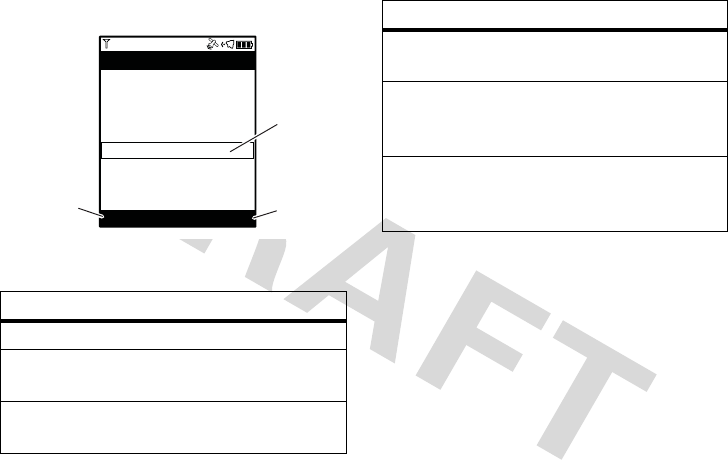
63
entertainment
Your phone displays the
My Music
menu:
The
My Music
menu includes:
Tip:
When you’re browsing through any of
these lists, to quickly jump to an entry, press
the first letter of the entry.
menu items
Playlists
Create or play a playlist.
Recently Played
View & play songs you
played recently.
Artists
Find & play music by an
artist.
My Music
Playlists
Recently Played
Artists
Albums
Songs
Genres
Options Exit
Highlighted
Selection
Press
Exit
to exit
MP3 player
.
Press
Options
to open
Options
menu.
Albums
Find & play music from a
specific album.
Songs
Find & play a song from the
entire list of songs on your
phone.
Genres
Find & play music from a
specific genre (type of
music) such as rock or jazz.
menu items
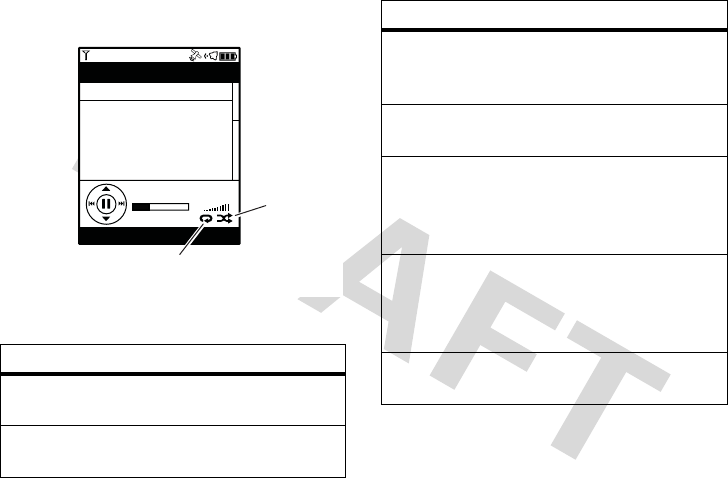
64
entertainment
While a song is playing on the music player,
your screen looks like this example:
Use these keys to control the music player:
controls
pause/play
Press &
release the center
key
s
.
fast forward
Ä
Press &
hold
S
right
for at
least two seconds.
All Songs
ne a Little Bit Closer.mp3
05 Come a Little Bit Clos. . .
Hello Moto.mp3
adrenaline
flawless
e a Little Bit Closer.mp
1:33 4:49
Options Back
When lit, indicates
Replay
turned on.
When lit,
indicates
Shuffle
turned on.
skip to next
song
Ä
Press &
release
S
right
.
rewind
Ã
Press &
hold
S
left
for at
least two seconds.
skip back to
previous
song
Ã
Within first two seconds of
song, press &
release
S
left
.
return to
song
beginning
Ã
After first two seconds of
song, press &
release
S
left
.
scroll up/
down
Press
S
up or down.
controls

65
entertainment
play music from a playlist
Find it:
l
>
Playlists
1
Scroll to the playlist you want and press
the center key
s
.
2
To play the entire playlist beginning with
the first song, press the center key
s
.
or
To play one song, scroll to the song you
want to play and press the center key
s
.
Tip:
To play all songs from all playlists, press
l
>
Playlists
. Press
Options
. Scroll to
Play
and
press
Select
.
play music from the recently
played list
Find it:
l
>
Recently Played
Scroll to a song and press the center key
s
.
find & play music by artist
Find it:
l
>
Artists
1
Scroll to the artist you want and press the
center key
s
.
2
Scroll to the album you want and press
the center key
s
.
3
To play the entire album beginning with
the first song, press the center key
s
.
or
turn off
music
player
Press
Back
until you return to
the
My Music
menu, then
press
Exit
.
or
Press
O
.
controls

66
entertainment
To play one song, scroll to the song you
want to play and press the center key
s
.
Tip:
To play all songs, press
l
>
Artists
.
Press
Options
. Scroll to the artist and press
Options
. Scroll to
Play
and press
Select
.
find & play music by album
Find it:
l
>
Albums
1
Scroll to the album you want and press
the center key
s
.
2
To play the entire album beginning with
the first song, press the center key
s
.
or
To play one song, scroll to the song you
want to play and press the center key
s
.
Tip:
To play all songs on an album, press
l
>
Albums
. Press
Options
. Scroll to
Play
and
press
Select
.
find & play music by songs
Find it:
l
>
Songs
To play all songs beginning with the first song
on the list, press the center key
s
.
or
To play one song, scroll to the song you want
and press the center key
s
.
find & play music by genre
Find it:
l
>
Genres
1
Scroll to the genre you want and press the
center key
s
.
2
Scroll to the artist you want and press the
center key
s
.
3
Scroll to the album you want and press
the center key
s
.
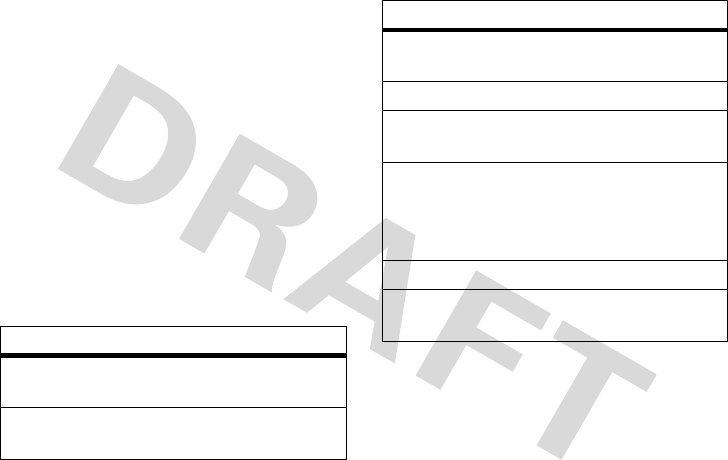
67
entertainment
4
To play the entire album beginning with
the first song, press the center key
s
.
or
To play one song, scroll to the song you
want to play and press the center key
s
.
Tip:
To play all songs in a genre, press
l
>
Genres
. Press
Options
. Scroll to
Play
and
press
Select
.
replay, shuffle, & other options
Press
Options
while using the music player to
choose from these options:
option
Now Playing
View the name of the song
currently playing.
Hide
Hide the music player
screen.
Play
Begin playing the current
selection.
Resume
Pause/resume play.
Song Details
View information about the
current selection.
Repeat
Replay one song (when you
select a single song for
play—does not play a
playlist or album).
Shuffle
Play songs in random order.
Visualization
Select an animation to play
with the music.
option
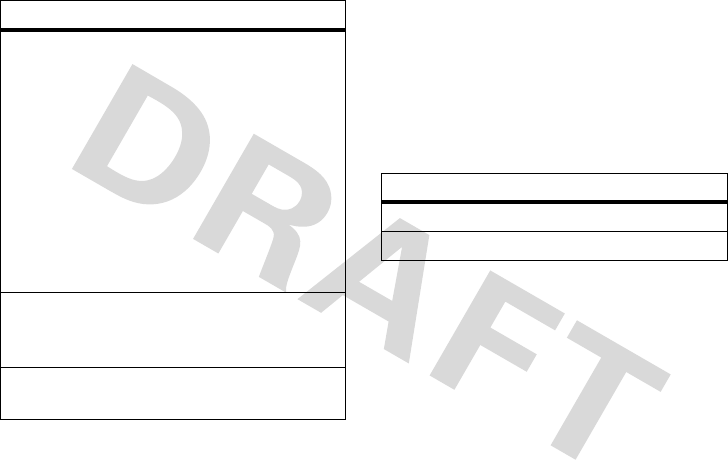
68
entertainment
wake up music player
While the music player is active, your phone
may conserve battery power by turning off the
display and keypad backlights if the slider is
open (see page 40).
To turn display and lights back on:
Search?
Set whether the player
searches for new music on
the memory card
when you
first activate the player
:
Always
—Search
automatically.
Ask
—Prompt you to begin or
skip searching.
Never
—Do not allow a search
when the player is activated.
Search for Songs?
Search for new music on the
memory card at any time
while using the player.
About
View detailed information
about the music player.
option
slider position
closed
Press the center key
s
.
open
Press a number key.
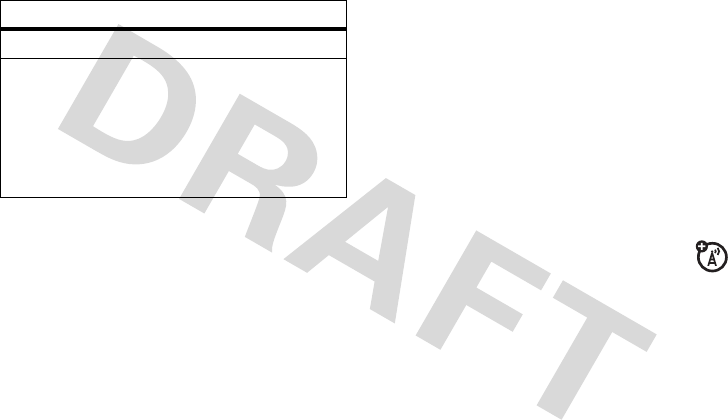
69
entertainment
turn off music player
music player tips
•
If you are navigating music player
menus while a song is playing and
don’t press a key for more than twenty
seconds, the player returns to the
current song list screen.
•
Turn off the player before connecting
the phone to a computer. If you
connect the phone to a computer while
the player is turned on, the phone
automatically turns off the player.
•
If you receive a call while playing
music, the music is paused. Playing
resumes when you end the call.
•
If the music player is hidden, you can
use other phone features. Using
applications like the camera or video
recorder pauses the music player. After
you close the applications, the player
resumes.
•
If you use a headset with the
phone while using the music
player, the music plays through the
headset. Music plays through the
phone speaker when the headset is
disconnected.
slider position
closed
Press
O
.
open
Press
Back
until you return to
the
My Music
menu, then
press
Exit
.
or
Press
O
.

70
entertainment
create & manage playlists
Personalize your music collection by creating
your own playlists.
When you name a playlist:
•
The name must be all lowercase
characters.
•
The name must be fewer than 32
characters.
•
The name cannot include these
characters:
/ \ : * ? < > | " !
Create
a playlist:
Find it:
l
>
Playlists
>
[Create New Playlist]
1
Enter a name for the playlist and press
Ok
.
2
Scroll to a desired song and press the
center key
s
.
When you select a song, a
\
appears
beside the song. (To unselect a song,
scroll to the song and press the center
key
s
again.)
Repeat this step until you have selected
all songs you want to add to the playlist.
3
Press
Done
when you have finished adding
songs.
Edit
a playlist:
Find it:
l
>
Playlists
1
Scroll to a desired playlist and press
Options
.
2
Scroll to
Edit Playlist
and press the center
key
s
.
3
Follow the steps for creating a playlist in
the previous section.
Reorder
a playlist:
Find it:
l
>
Playlists

71
entertainment
1
Scroll to
Options
and press the center
key
s
.
2
Scroll to
Reorder Playlist
and press the center
key
s
.
3
Scroll to the song whose position you
want to change press
Grab
.
4
Scroll to the position in the playlist where
you want to move the song, and press
Insert
.
5
Repeat these steps until you have
reordered the playlist as you prefer.
6
Press
Done
to return to the
Playlists
menu.
Delete
a playlist:
Find it:
l
>
Playlists
1
Scroll to a desired playlist and press
Options
.
2
Scroll to
Delete Playlist
and press the center
key
s
.
3
When prompted to confirm the deletion,
press
Yes
.
take & send photo
You can take a photo with your phone and
sent it in a multimedia message to other
wireless phone users.
Your camera lens is on the back of your phone
when the phone is open (see page 3).
To g e t
the clearest video clips, wipe the lens
clean with a soft, dry cloth before you
capture a video clip.
take & send photo
To activate your phone’s camera,
press and
hold
the music/camera key
l
.
or
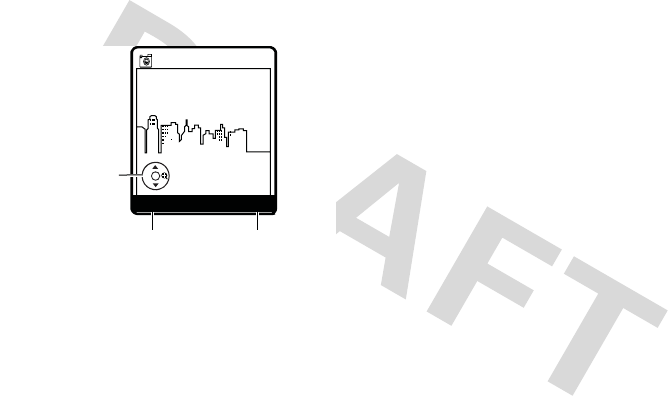
72
entertainment
Open your phone and press
s
>
hMedia
Gallery
>
Camera
.
Your phone displays the active
viewfinder image:
1
Point the camera lens at the subject.
Press
S
up and down
to select and
adjust one of the following settings
:
Zoom
—Increase or decrease image size.
Style
—Set to
Color
,
Black and White
,
Antique
, or
Negative
.
Lighting Conditions
—Set to
Automatic
,
Sunny
,
Cloudy
, I
ndoor (Home)
,
Indoor (Office)
, or
Night
.
To view other options,
press
Options
(see
page 73).
2
Press the center key
s
.
3
Press
Options
, then select
Store Only
to save
the photo,
Discard
to discard the photo, or
Print
to print the photo using a
Bluetooth connection.
or
Press
Send
to save the photo and go to the
Send Options
screen. Then select
Send in
Message
or
Send to Online Album
.
ß
480x640
Press right soft
key to return to
previous screen.
Press left soft
key to view
Options menu.
Options Exit
N
Zoom
1x
621
Displays when
you press
S
to
change photo
settings.
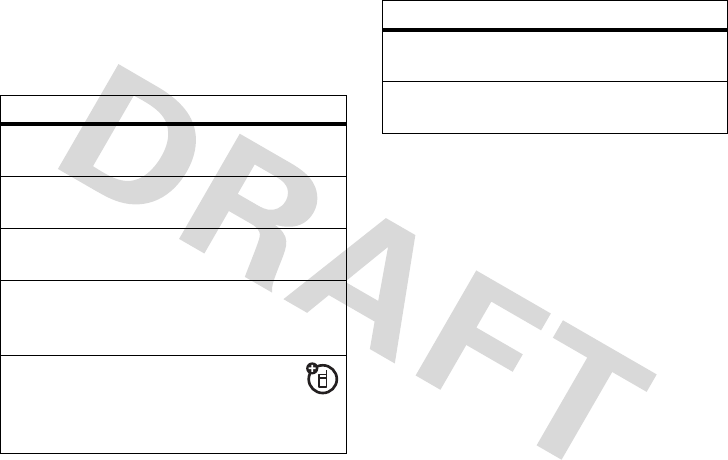
73
entertainment
adjust camera settings
When the camera is active, press
Options
to
view and select these options:
change screen orientation
When you turn on the camera with the slider
closed, the view finder is in landscape mode.
To use the camera in portrait mode, activate
the camera with the slider closed.
option
Go To Pictures
View pictures and photos
stored on your phone.
Go To Video
Mode
Switch to the video camera
viewfinder.
Auto-Timed
Capture
Set a timer for the camera
to take a photo.
Camera Setup
Change
Resolution
or image
Quality
, or activate a
Shutter
Tone
.
Switch Storage
Device
Store photos in phone
memory or on an
optional memory card
(see page 31).
Free Space
See how much memory
remains for storing pictures.
Capture Title
Assign a name to a captured
photo.
option
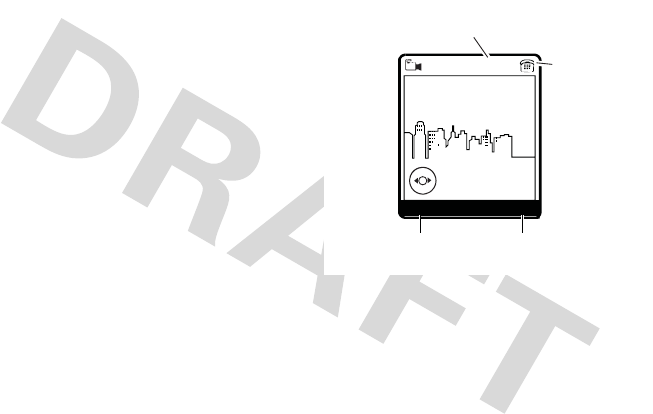
74
entertainment
record & play video
clips
You can record a video clip with your phone
and send it in a multimedia message to other
wireless phone users.
Your camera lens is on the back of your phone
when the phone is open (see page 3).
To g e t
the clearest video clips, wipe the lens
clean with a soft, dry cloth before you
capture a video clip.
record a clip
To activate your phone’s video camera:
Find it:
s
>
hMedia Gallery
>
Video Camera
The active video camera viewfinder image
appears on your phone’s screen:
1
Point the camera lens at the video
subject.
Press
S
left and right to specify lighting
conditions (
Automatic
,
Sunny
,
Cloudy
,
Indoor
(Home)
,
Indoor (Office)
, or
Night
.
480x640
Press right soft key to
return to previous screen.
Press left soft key to
view
Options
menu.
Options Exit
N
Lighting Conditions
Indoor (Home)
28
Storage
(Phone or
Memory
Card)
Remaining
Video Minutes
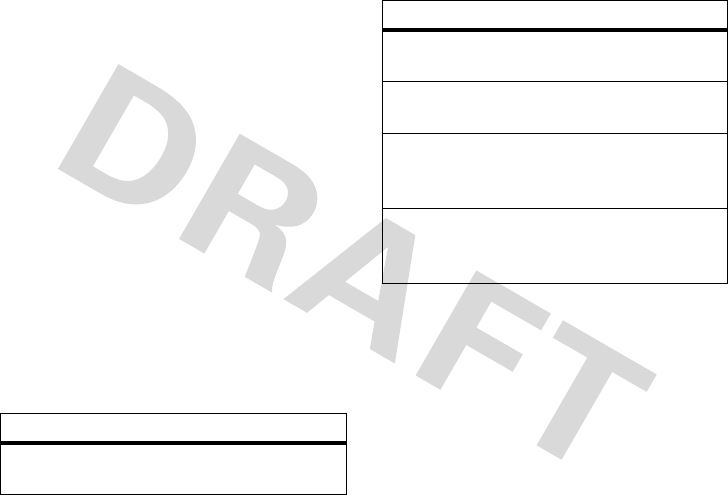
75
entertainment
Press
Options
to view and select other
options (see the next section).
2
Press the center key
s
to begin
recording.
3
Press
Stop
to stop recording.
4
Press
Options
, then select
Store Only
to save
the video clip or
Discard
to discard the clip.
or
Press
Send
to save the video clip and go to
the
Send Options
screen. Then select
Send in
Message
or
Send to Online Album
.
adjust video camera settings
When the video camera is active, press
Options
to view and select these options:
play video clip
To play a video clip stored on your phone:
Find it:
s
>
hMedia Gallery
>
Videos
Scroll to the clip you want to view and press
the center key
s
.
option
Go To Videos
View video clips stored on
your phone.
Go To Photo Mode
Switch to the still photo
camera viewfinder.
Video Camera
Setup
Change
Video Length
or
Recording Sound
.
Switch Storage
Device
Specify where you want to
save video clips (phone
memory or memory card).
Free Space
See how much memory
remains for storing video
clips.
option
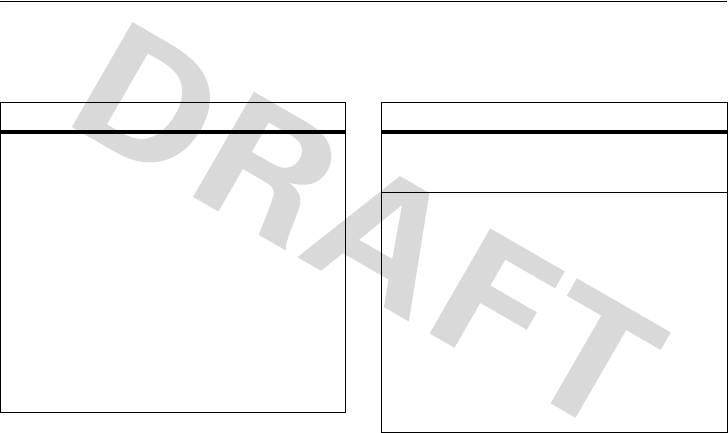
76
other features—advanced calling
other features
advanced calling phonebook
features
voice dial
Press and release the voice key (on the
right side of the phone), then (within two
seconds) say:
•
“Name dial,” followed by the name of
a
Contacts
entry.
or
•
“Digit dial,” followed by a number.
You can use
Digit Dial
for numbers stored in
Contacts.
features
create entry
s
>
nContacts
>
[New Entry]
edit entry
s
>
nContacts
Scroll to the entry and press
Options
, then
scroll to
Edit Contact
and press
Select
to edit the
entry. Press
Done
to save your changes.
You can also edit an entry just before calling
the number by pressing
Options
, then
scrolling to
Edit Before Call
and pressing
Select
to
edit the entry.
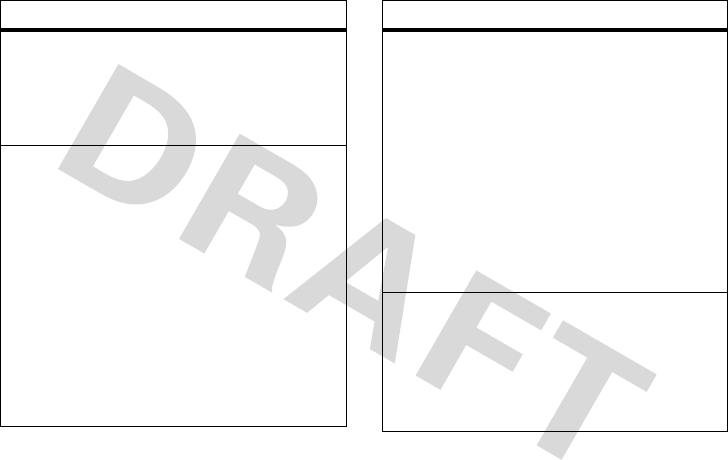
other features—phonebook
77
delete entry
s
>
nContacts
Scroll to the entry and press
Options
, then
scroll to
Delete Contact
and press
Select
.
set ringer ID for an entry
Assign a ring alert (ringer ID) to an entry:
s
>
nContacts
Scroll to the entry and press
Options
, then
scroll to
Edit Contact
and press
Select
. Scroll to
Ringer ID
and press the center key
s
. Scroll
to the desired ringer_name and press
Select
,
then press
Done
to save the setting.
Activate ringer IDs:
s
>
tRing Styles
> style
Detail
>
Ringer IDs
features
set picture ID for an entry
Assign a photo or picture to show when you
receive a call from an entry:
s
>
nContacts
Scroll to the entry and press
Options
, then
scroll to
Edit Contact
and press
Select
. Scroll to
Picture
and press the center key
s
. Select
either
Take Picture
to activate the camera or
Select Picture
to select from the pictures you
already have. Press
Done
to save your choice.
set speed dial number
s
>
nContacts
Scroll to the entry and press
Options
, then
scroll to
AddtoSpeedDial
and press
Select
. Scroll
to a number and press
Select
.
features
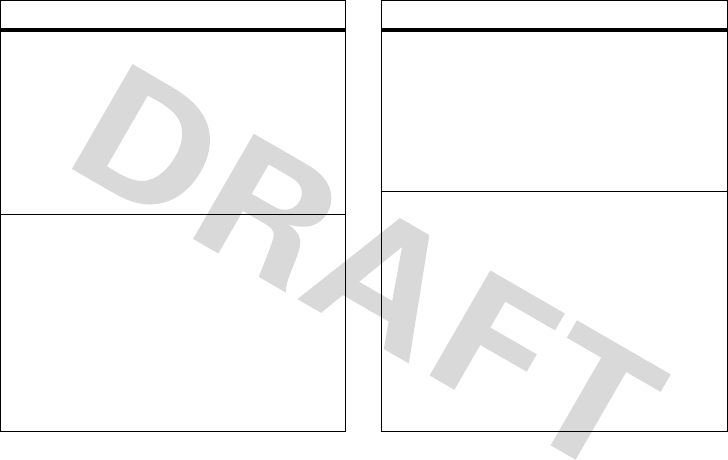
78
other features—phonebook
print entry
s
>
nContacts
Scroll to the entry and press
Options
, then
scroll to
Print
and press
Select
. When
prompted, select a Bluetooth printer or
connect to a computer by using a USB
cable. See page 58.
set entry view
List contacts by first or last name and view
picture or list format.
s
>
nContacts
Press
Options
, then scroll to
Setup
and press
Select
. Scroll to
Sort by
and select
First Name
or
Last Name
. Scroll to
View by
and select
List
or
Picture
. Press
Done
to save your selection.
features
set category for an entry
s
>
nContacts
Scroll to the entry and press
Options
, then
scroll to
Edit Contact
and press
Select
. Scroll to
Category
, then scroll to and select a category.
Press
Done
to save your selection.
create mailing list
Create a message list (mailing list) as a
single Contacts entry:
s
>
nContacts
>
[New Entry]
>
Options
>
Create New
>
Message List
You can add or delete entries to or from a
message list. When you send a message to
a message list, the message goes to all
Contacts entries in that list.
features
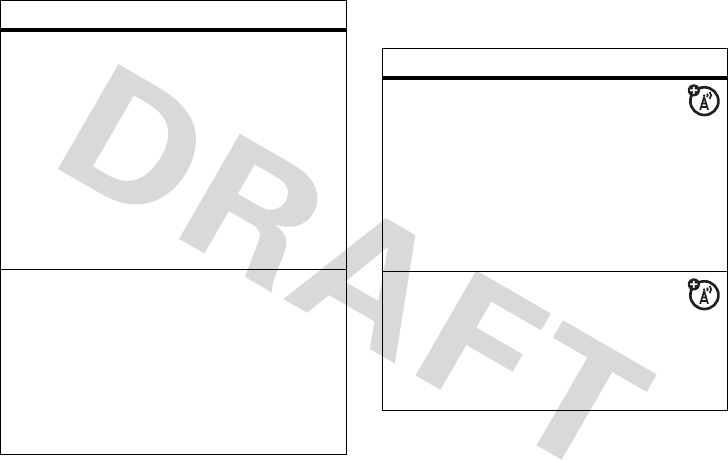
other features—messages
79
messages
sort entries
You can show
All
entries, entries in a
predefined category, or entries in a
category you create.
s
>
nContacts
Press
Options
, then scroll to
Filter by
and press
Select
. Choose from
All Phone Contacts
,
Email
, or
Category
and press the center key
s
. Press
Exit
to save your selection.
manage entries
s
>
nContacts
Press
Options
, then scroll to
Manage Contacts
and
press
Select
. Choose
Speed Dial
to manage all
speed dial entries,
Edit Categories
to manage all
categories, or
Phone Capacity
to see how much
space you have used for entries.
features
features
send text message
s
>
eMessaging
>
Create Message
Press
Options
to perform various actions on
the message.
You can also select a contact first, press
Options
, and select
Send Message
to compose a
message.
use MMS template
Open an MMS template with
preloaded media:
s
>
eMessaging
>
Create Message
>
Picture Msg Templates
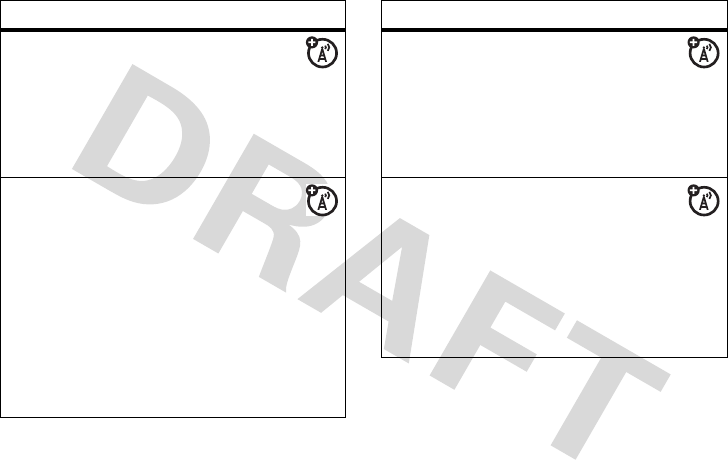
80
other features—messages
view sent messages
s
>
eMessaging
>
Outbox
Scroll to the message and press
Open
(
r
).
Press
Options
to perform various actions on
the message.
send quick text
Quick Text is a prewritten message
that you can quickly select and send. Your
phone comes with several quick notes, and
you can create additional ones.
s
>
eMessaging
>
Quick Text
Scroll to the quick text you want to send
and press
Options
, then scroll to
Send
and
press
Select
.
features
read received messages
s
>
eMessaging
>
Inbox
Scroll to the message and press
Open
(
r
).
Press
Options
to perform various actions on
the message.
drafts
View messages saved in
Drafts
folder:
s
>
eMessaging
>
Drafts
Scroll to the message and press
Open
(
s
).
Press
Options
to perform various actions on
the message.
features
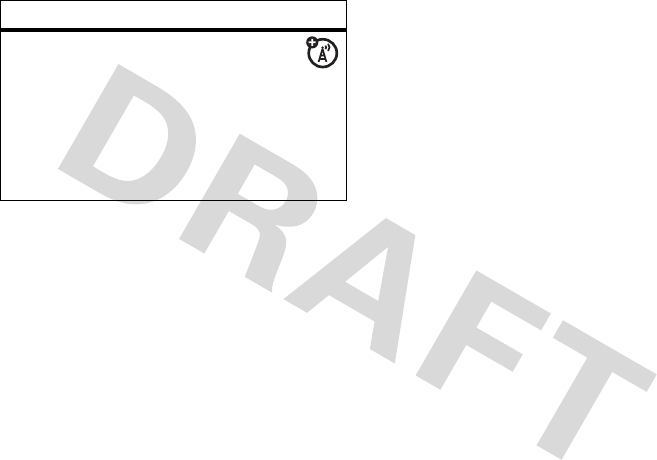
other features—personalize
81
personalize
speech commands
Advanced Speech Recognition enables you to
place calls and access some menu options by
speaking commands to your phone.
1
Press and release the voice key on the
right side of the phone.
Your phone displays and speaks
Say a
command
, followed by a list of voice
commands.
Note:
If the speakerphone is not turned
on and you want to activate it, press the
smart/speakerphone key.
2
Say one of the following commands:
Name
Dial
,
Digit Dial
,
Voicemail
,
Redial
, or
Received
.
Tip:
Speak numbers at a normal speed
and volume, pronouncing each digit
distinctly. Avoid pausing between digits.
Your phone opens the corresponding
menu or performs the corresponding
action.
adapt advanced speech
recognition to your voice
For most people, Advanced Speech
Recognition works well for voice dialing
erase messages
Delete all messages or only
messages from the
Outbox
or
Drafts
folder:
s
>
eMessaging
Press
Options
, then scroll to and select
Erase Messages
. Then select
All
,
Outbox
, or
Drafts
.
features

82
other features—personalize
without any initial setup. However, if the
phone is frequently unable to recognize
numbers correctly when you use voice
dialing, you may be able to improve your
results by adapting it to your voice.
Note:
If the phone is used by several people,
reset voice dialing to the original setting
before proceeding. This ensures that you are
not saving your settings over someone else’s.
Find it:
s
>
wSettings
>
Personalize
>
Voice DialSetup
>
Adapt Digits
1
Press
START
.
2
When the phone prompts you to say the
first digit sequence, wait for the beep,
then repeat the digits in a normal tone of
voice.
3
If the recording sounds acceptable (no
mistakes or background noises), say
“Yes” or press
YES
.
or
If the recording is not acceptable, say
“No” or press
NO
. When prompted to say
the digits again, wait for the beep and say
the digits again. The phone will prompt
you to repeat this process with up to
twelve additional sets of digits.
4
When the phone prompts, “More
Adaptation?”, press
YES
to continue or
NO
to end the process.
When the adaptation process is complete,
the phone will say “Adaptation Complete.”
Tip:
When adapting speech recognition to
your voice:
•
Choose a quiet place for recording.
•
Wait for the beep before you speak.
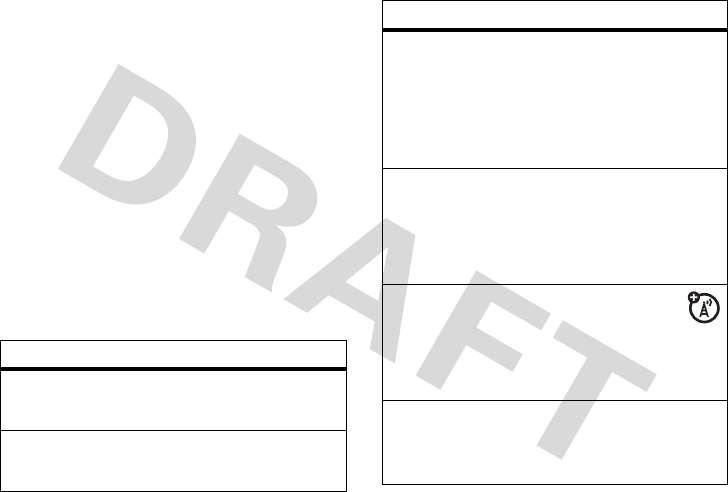
other features—personalize
83
•
Speak at a normal speed and volume,
pronouncing each digit distinctly. Avoid
pausing between digits.
•
If you make a mistake while recording
a sequence of digits, or if an
unexpected noise spoils the recording,
record that sequence again.
To reset speech recognition to the factory
defaults:
Find it:
s
>
wSettings
>
Personalize
>
Voice DialSetup
>
Reset Digits
more personalizing features
features
ring volume
s
>
tRing Styles
> Style
Detail
>
Ring Volume
keypad volume
s
>
tRing Styles
> Style
Detail
>
Key Volume
reminders
Set your phone to play reminder alerts for
picture, text, or voicemail messages that
you receive:
s
>
tRing Styles
> Style
Detail
>
Reminders
skin
Choose a phone skin that sets the look and
feel of your phone’s screen:
s
>
wSettings
>
Personalize
>
Skin
greeting
Change the greeting that appears
when you turn on your phone:
s
>
wSettings
>
Personalize
>
Greeting
change home screen soft key labels
s
>
wSettings
>
Personalize
>
Home Screen
>
Home Keys
>
Left Soft Key
or
RightSoftKey
features
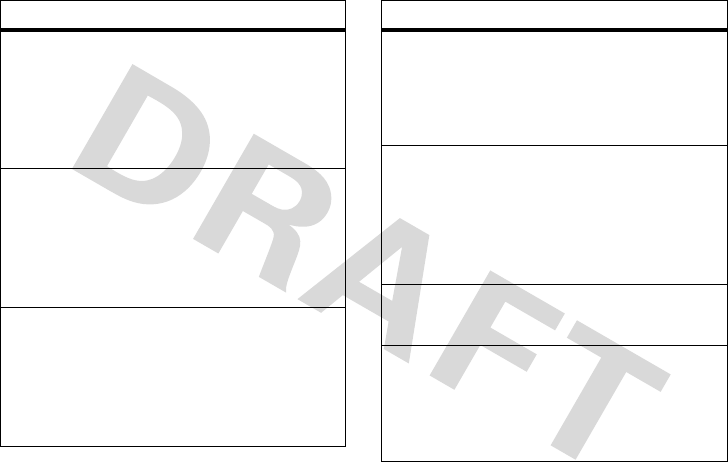
84
other features—personalize
banner
Create a heading to display on your phone’s
home screen:
s
>
wSettings
>
Personalize
>
Main Menu
>
Banner
text layout
Set home screen text to be left justified or
centered:
s
>
wSettings
>
Personalize
>
Home Screen
>
Layout
clock view
Display an analog clock or digital time
readout in the home screen:
s
>
wSettings
>
Personalize
>
Home Screen
>
Clock
features
menu view
Display the main menu as icons or a text
list:
s
>
wSettings
>
Personalize
>
Main Menu
>
View
show or hide menu icons
Show or hide menu feature icons in the
home screen:
s
>
wSettings
>
Personalize
>
Home Screen
>
Home Keys
>
Icons
menu language
s
>
wSettings
>
Initial Setup
>
Language
scroll
Set the scroll bar to stop or wrap around in
menu lists:
s
>
wSettings
>
Initial Setup
>
Scroll
features
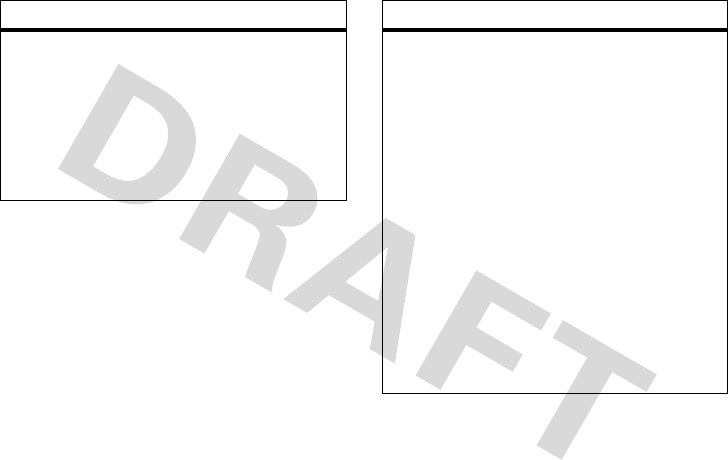
other features—personalize
85
master reset
Reset all options except unlock code,
security code, and lifetime timer:
s
>
wSettings
>
Initial Setup
>
Master Reset
To reset all options, you need to enter the
Security Code
(000000).
features
master clear
Reset all options except unlock code,
security code, and lifetime timer, and clear
all user settings and entries:
This option erases all user-entered
information stored in your phone memory,
including Contacts entries and downloaded
files. Once you erase the information, it
cannot be recovered. It resets all options to
their factory settings except for the unlock
code, security code, and lifetime timer.
s
>
wSettings
>
Initial Setup
>
Master Clear
To reset all options, you need to enter the
Security Code
(000000).
features
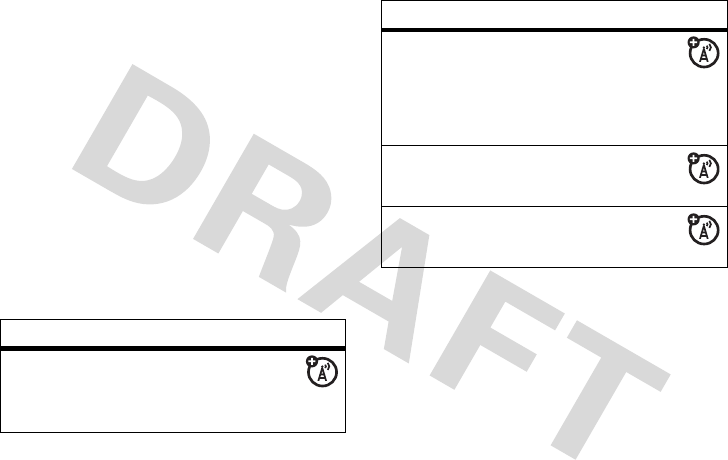
86
other features—call times
call times
Network connection time
is the elapsed
time from the moment you connect to your
service provider’s network to the moment
you end the call by pressing
O
. This time
includes busy signals and ringing.
The amount of network connection time
you track on your resettable timer may not
equal the amount of time for which you
are billed by your service provider. For
billing information, please contact your
service provider directly.
handsfree
Note:
The use of wireless devices and their
accessories may be prohibited or restricted in
features
set in-call timer
s
>
wSettings
>
In-Call Setup
>
In-Call Timer
view call times
s
>
sRecent Calls
>
Call Times
Scroll to
Last Call
,
Dialed
,
Received
,
All Calls
, or
Lifetime Calls
, and press
Select
.
view data times
s
>
sRecent Calls
>
DataTimes
view data volumes
s
>
sRecent Calls
>
DataVolumes
features
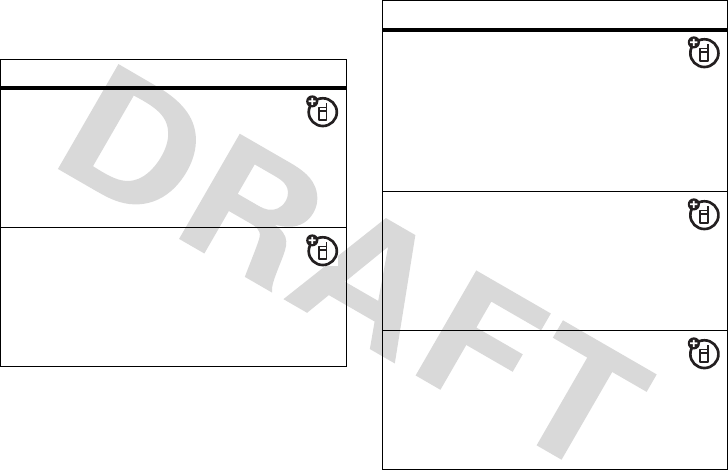
other features—handsfree
87
certain areas. Always obey the laws and
regulations on the use of these products.
features
accessory volume settings
(car kit or headset)
Adjust volume levels of car kit accessory:
During an active call, press the up or down
volume keys.
external speakerphone
Activate a connected external
speakerphone during a call:
Press the smart/speakerphone key on the
side of the phone.
auto answer
(car kit or headset)
Automatically answer calls when connected
to a car kit or headset:
s
>
wSettings
>
Car Settings
or
Headset
>
Auto Answer
voice dial
(headset)
Enable voice dial with headset send/end
key:
s
>
wSettings
>
Headset
>
Voice Dial
auto handsfree
(car kit)
Automatically route calls to a car kit when
connected:
s
>
wSettings
>
Car Settings
>
Auto Handsfree
features
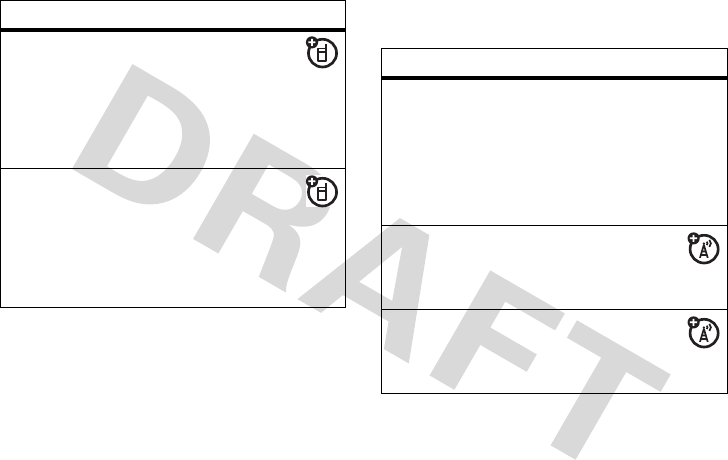
88
other features—data & fax calls
data & fax calls
power-off delay
(car kit)
Set the phone to stay on for a period of
time after the ignition is switched off:
s
>
wSettings
>
Car Settings
>
Power-off Delay
charger time
(car kit)
Charge your phone for a period of time after
the ignition is switched off:
s
>
wSettings
>
Car Settings
>
Charger Time
features
features
data settings
Specify call type for next call:
s
>
wSettings
>
Connection
>
Incoming Call
Scroll to
Next Call
and press
Change
, then select
Normal
,
Data In Only
, or
Fax In Only
.
send data or fax
Connect your phone to the device,
then place the call through the device.
receive data or fax
Connect your phone to the device,
then answer the call through the device.
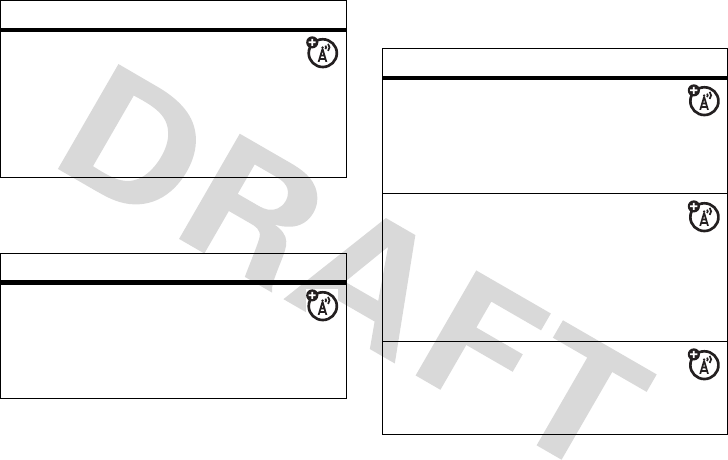
other features—network
89
network
personal organizer
talk then fax
Connect your phone to the device,
then:
s
>
Dialing Menu
>
Talk Then Fax
Press
N
to make the call.
features
network settings
View network information and adjust
network settings:
s
>
wSettings
>
Network Options
features
features
add datebook event
s
>
ÉTools
>
8Datebook
Scroll to the desired day and press
Options
,
then scroll to
New
and press
Select
.
view datebook event
View or edit event details:
s
>
ÉTools
>
8Datebook
Scroll to the desired day and press
s
, then
scroll to the event and press
s
.
event reminder
Press
View
to view an event reminder.
Press
Exit
to dismiss an event reminder.
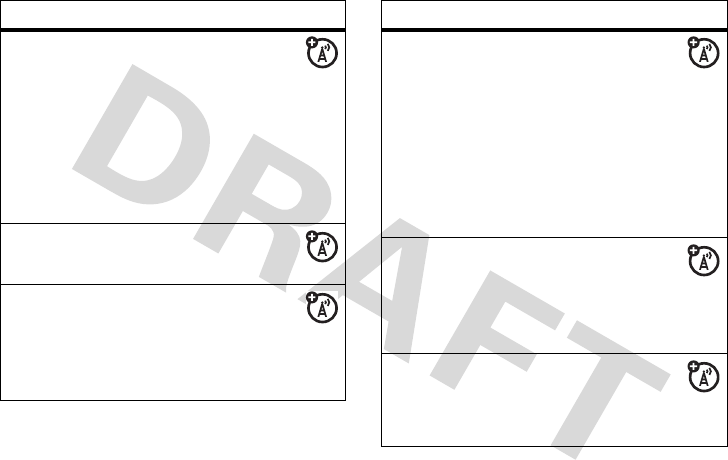
90
other features—personal organizer
copy datebook event
Copy a datebook event to another
date and/or time:
s
>
ÉTools
>
8Datebook
Scroll to the desired day and press
s
, then
scroll to the event and press
Options
. Scroll to
Copy
and press
Select
.
set alarm
s
>
ÉTools
>
Alarm Clock
turn off alarm
To turn off an alarm, press
Disable
or
O
.
To set an eight-minute delay, press
SNOOZE
.
features
create voice record
Note:
Recording phone calls is
subject to varying state and federal laws
regarding privacy and recording of
conversations.
Press and hold the voice key and begin
recording. Release the voice key when
finished.
play voice record
s
>
ÉTools
>
ÜVoice Records
Scroll to the voice record you wish to play
and press
s
.
calculator
Calculate numbers:
s
>
ÉTools
>
Calculator
features
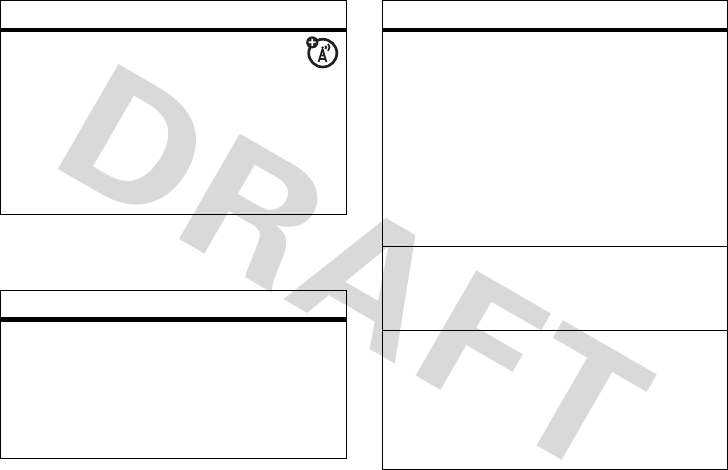
other features—security
91
security
convert currency
s
>
ÉTools
>
Calculator
Press
Options
, then scroll to
Exchange Rate
and
press
Select
. Enter the desired exchange rate
and press
Ok
. Enter the amount to be
converted, then press
Options
. Scroll to
Convert
Currency
and press
Select
.
features
lock application
s
>
wSettings
>
Security
>
Lock Application
When prompted, enter the unlock code and
press
Ok
. Then scroll to the application you
wish to lock and press
Change
.
features
restrict calls
Restrict outgoing or incoming calls:
s
>
wSettings
>
Security
>
Restrict Calls
When prompted, enter the unlock code and
press
Ok
. Select
Outgoing Calls
or
Incoming Calls
and press Change. With
Allow:
highlighted,
press
Change
, then select
All
,
None
, or
Contacts
,
and press
Select
.
change unlock and security codes
s
>
wSettings
>
Security
>
New Passwords
>
Unlock Code
or
Security Code
control location
Set up a location code to control access to
the
Location
function:
s
>
wSettings
>
Security
>
New Passwords
>
Location Code
features
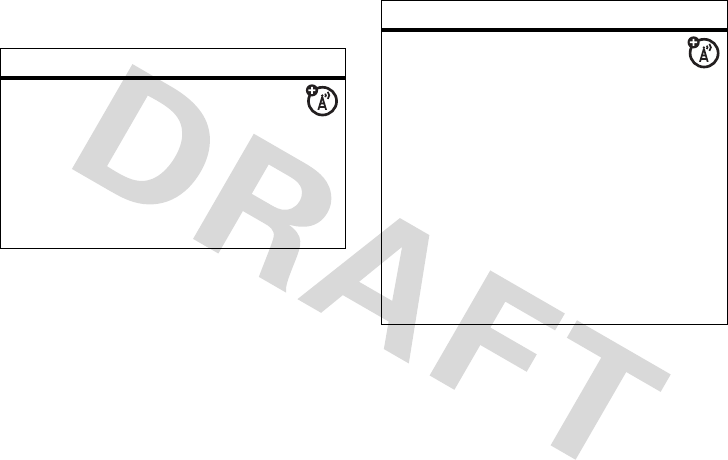
92
other features—fun & games
fun & games
features
launch browser
Start a browser session:
s
>
JBREW
Note:
The menu option on your phone for
starting a browser session may be different
than the one shown above.
manage pictures
s
>
hMediaGallery
>
Pictures
To view a picture, scroll to the picture title
and press
s
.
Press
Options
to open the
Pictures Menu
, which
can include the following options:
Send In
Message
,
Send to online album
,
Apply As
,
Zoom
,
New
,
Details
,
Change Details
,
Delete
,
Move
,
Copy
,
Mark
,
Mark
All
,
Assign to Category
,
View Free Space
.
Note:
The
Pictures Menu
includes different
options for locked or preloaded images.
features
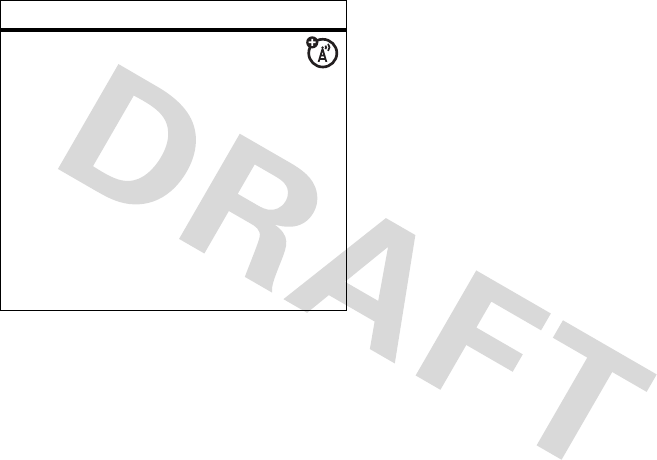
other features—fun & games
93
manage sounds
Manage sounds and create playlists:
s
>
hMediaGallery
>
Sounds
To play a sound, scroll to the sound title and
press
s
.
To create a playlist, scroll to
[New Playlist]
and
press
s
.
Press
Options
to open the
Sounds Menu
, which
can include the following options:
New
,
Categories
,
Sounds Setup
,
View Free Space
.
features

94
service & repairs
service & repairs
If you have questions or need assistance,
we’re here to help.
Go to
www.motorola.com/consumer/
support
, where you can select from a
number of customer care options. You can
also contact the Motorola Customer Support
Center at 1-800-331-6456 (United States),
1-888-390-6456 (/TDD United States for
hearing impaired), or 1-800-461-4575
(Canada).

SAR Data
95
Specific Absorption Rate Data
SAR Da ta
This model wireless phone meets the
government’s requirements for exposure to radio
waves.
Your wireless phone is a radio transmitter and receiver. It is
designed and manufactured not to exceed limits for exposure to
radio frequency (RF) energy set by the Federal Communications
Commission (FCC) of the U.S. Government and by the Canadian
regulatory authorities. These limits are part of comprehensive
guidelines and establish permitted levels of RF energy for the
general population. The guidelines are based on standards that
were developed by independent scientific organizations through
periodic and thorough evaluation of scientific studies. The
standards include a substantial safety margin designed to assure
the safety of all persons, regardless of age or health.
The exposure standard for wireless mobile phones employs a unit
of measurement known as the Specific Absorption Rate, or SAR.
The SAR limit set by the FCC and by the Canadian regulatory
authorities is 1.6 W/kg.
1
Tests for SAR are conducted using
standard operating positions accepted by the FCC and by Industry
Canada with the phone transmitting at its highest certified power
level in all tested frequency bands. Although the SAR is
determined at the highest certified power level, the actual SAR
level of the phone while operating can be well below the
maximum value. This is because the phone is designed to operate
at multiple power levels so as to use only the power required to
reach the network. In general, the closer you are to a wireless
base station, the lower the power output.
Before a phone model is available for sale to the public in the U.S.
and Canada, it must be tested and certified to the FCC and Industry
Canada that it does not exceed the limit established by each
government for safe exposure. The tests are performed in
positions and locations (e.g., at the ear and worn on the body)
reported to the FCC and available for review by Industry Canada.
The highest SAR value for this model phone when tested for use at
the ear is 1.23 W/kg, and when worn on the body, as described in
this user guide, is 1.07 W/kg. (Body-worn measurements differ
among phone models, depending upon available accessories and
regulatory requirements).
2
While there may be differences between the SAR levels of various
phones and at various positions, they all meet the governmental
requirements for safe exposure. Please note that improvements to
this product model could cause differences in the SAR value for
later products; in all cases, products are designed to be within the
guidelines.

96
SAR Data
Additional information on Specific Absorption Rates (SAR) can be
found on the Cellular Telecommunications & Internet Association
(CTIA) Web site:
http://www.phonefacts.net
or the Canadian Wireless Telecommunications Association (CWTA)
Web site:
http://www.cwta.ca
1. In the United States and Canada, the SAR limit for mobile phones used
by the public is 1.6 watts/kg (W/kg) averaged over one gram of tissue.
The standard incorporates a substantial margin of safety to give
additional protection for the public and to account for any variations in
measurements.
2. The SAR information includes the Motorola testing protocol,
assessment procedure, and measurement uncertainty range for this
product.
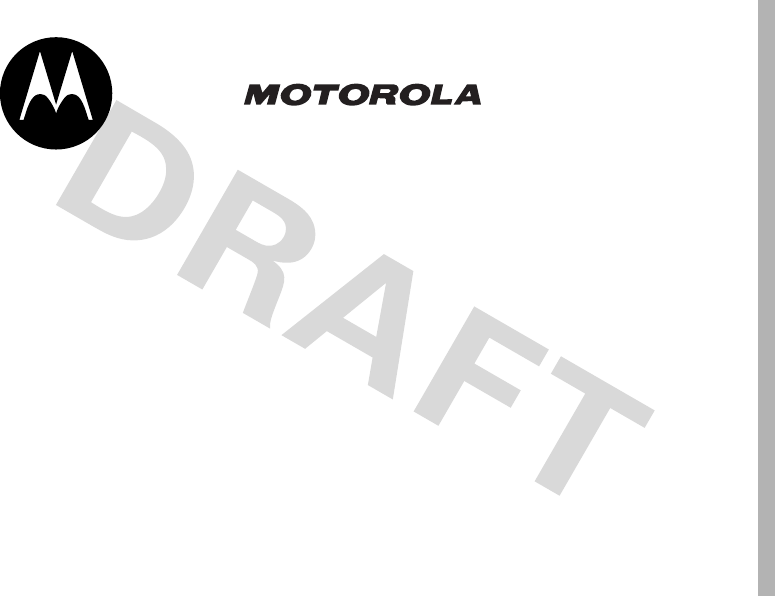
97
Important Safety and
Legal Information

98
Safety Information
Safety and General Information
Safe ty Infor mation
This section contains important information on the safe and
efficient operation of your mobile device. Read this
information before using your mobile device.
*
Exposure to Radio Frequency (RF)
Energy
Your mobile device contains a transmitter and receiver. When it is
ON, it receives and transmits RF energy. When you communicate
with your mobile device, the system handling your call controls the
power level at which your mobile device transmits.
Your Motorola mobile device is designed to comply with local
regulatory requirements in your country concerning exposure of
human beings to RF energy.
Operational Precautions
For optimal mobile device performance and to be sure that human
exposure to RF energy does not exceed the guidelines set forth in
the relevant standards, always follow these instructions and
precautions.
External Antenna Care
If your mobile device has an external antenna, use only a
Motorola-supplied or approved replacement antenna. Use of
unauthorized antennas, modifications, or attachments could
damage the mobile device and/or may result in your device not
complying with local regulatory requirements in your country.
DO NOT hold the external antenna when the mobile device is IN
USE. Holding the external antenna affects call quality and may
cause the mobile device to operate at a higher power level than
needed.
Product Operation
When placing or receiving a phone call, hold your mobile device
just like you would a landline phone.
If you wear the mobile device on your body, always place the
mobile device in a Motorola-supplied or approved clip, holder,
holster, case, or body harness. If you do not use a body-worn
accessory supplied or approved by Motorola, keep the mobile
device and its antenna at least 2.5 centimeters (1 inch) from your
body when transmitting.
* The information provided in this document supersedes the general
safety information in user’s guides published prior to May 1, 2006.

Safety Information
99
When using any data feature of the mobile device, with or without
an accessory cable, position the mobile device and its antenna at
least 2.5 centimeters (1 inch) from your body.
Using accessories not supplied or approved by Motorola may
cause your mobile device to exceed RF energy exposure
guidelines. For a list of Motorola-supplied or approved
accessories, visit our Web site at:
www.motorola.com
.
RF Energy Interference/Compatibility
Nearly every electronic device is subject to RF energy interference
from external sources if inadequately shielded, designed, or
otherwise configured for RF energy compatibility. In some
circumstances your mobile device may cause interference with
other devices.
Follow Instructions to Avoid Interference
Problems
Turn off your mobile device in any location where posted notices
instruct you to do so. These locations include hospitals or health
care facilities that may be using equipment that is sensitive to
external RF energy.
In an aircraft, turn off your mobile device whenever instructed to
do so by airline staff. If your mobile device offers an airplane mode
or similar feature, consult airline staff about using it in flight.
Pacemakers
If you have a pacemaker, consult your physician before using this
device.
Persons with pacemakers should observe the following
precautions:
•
ALWAYS keep the mobile device more than
20 centimeters (8 inches) from your pacemaker when the
mobile device is turned ON.
•
DO NOT carry the mobile device in the breast pocket.
•
Use the ear opposite the pacemaker to minimize the
potential for interference.
•
Turn OFF the mobile device immediately if you have any
reason to suspect that interference is taking place.
Hearing Aids
Some mobile devices may interfere with some hearing aids. In the
event of such interference, you may want to consult your hearing
aid manufacturer or physician to discuss alternatives.
Other Medical Devices
If you use any other personal medical device, consult your
physician or the manufacturer of your device to determine if it is
adequately shielded from RF energy.

100
Safety Information
Driving Precautions
Check the laws and regulations on the use of mobile devices in the
area where you drive. Always obey them.
When using your mobile device while driving, please:
•
Give full attention to driving and to the road. Using a
mobile device may be distracting. Discontinue a call if you
can’t concentrate on driving.
•
Use handsfree operation, if available.
•
Pull off the road and park before making or answering a
call if driving conditions so require.
Responsible driving practices can be found in the “Smart Practices
While Driving” section at the end of this guide and/or at the
Motorola Web site:
www.motorola.com/callsmart
.
Operational Warnings
Obey all posted signs when using mobile devices in public areas,
such as health care facilities or blasting areas.
Automobile Air Bags
Do not place a mobile device in the air bag deployment area.
Potentially Explosive Atmospheres
Areas with potentially explosive atmospheres are often but not
always posted, and can include fueling areas such as below decks
on boats, fuel or chemical transfer or storage facilities, or areas
where the air contains chemicals or particles, such as grain, dust,
or metal powders.
When you are in such an area, turn off your mobile device, and do
not remove, install, or charge batteries. In such areas, sparks can
occur and cause an explosion or fire.
Damaged Products
If your mobile device or battery has been submerged in water,
punctured, or subjected to a severe fall, do not use it until you take
it to a Motorola Authorized Service Center. Do not attempt to dry it
with an external heat source, such as a microwave oven.
Batteries and Chargers
If jewelry, keys, beaded chains, or other conductive
materials touch exposed battery terminals, this
could complete an electrical circuit (short circuit),
become very hot, and could cause damage or
injury. Be careful when handling a charged battery,
particularly when placing it inside a pocket, purse, or other
container with metal objects.
Use only Motorola Original
batteries and chargers.
Caution:
To avoid risk of personal injury, do not dispose of your
battery in a fire.
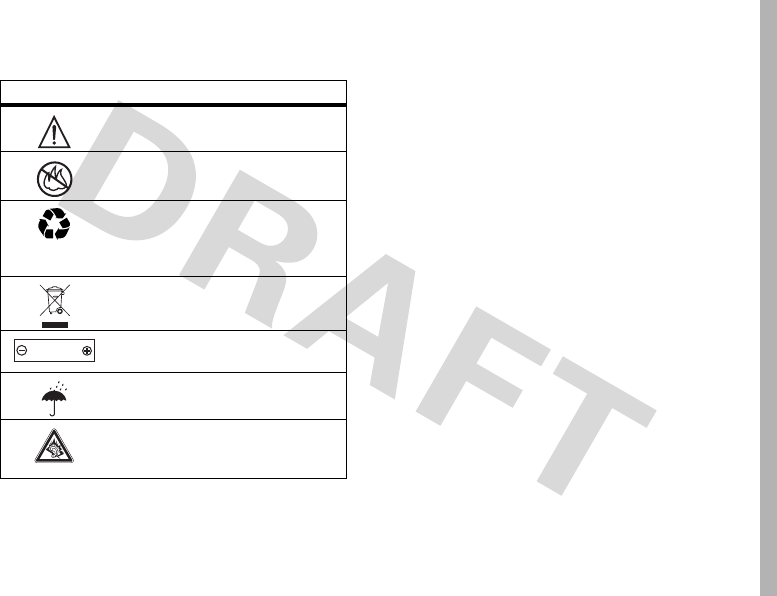
Safety Information
101
Your battery, charger, or mobile device may contain symbols,
defined as follows:
Choking Hazards
Your mobile device or its accessories may include detachable
parts, which may present a choking hazard to small children. Keep
your mobile device and its accessories away from small children.
Glass Parts
Some parts of your mobile device may be made of glass. This glass
could break if the product is dropped on a hard surface or receives
a substantial impact. If glass breaks, do not touch or attempt to
remove. Stop using your mobile device until the glass is replaced
by a qualified service center.
Seizures/Blackouts
Some people may be susceptible to epileptic seizures or blackouts
when exposed to flashing lights, such as when playing video
games. These may occur even if a person has never had a previous
seizure or blackout.
If you have experienced seizures or blackouts, or if you have a
family history of such occurrences, please consult with your
physician before playing video games or enabling a flashing-lights
feature (if available) on your mobile device.
Discontinue use and consult a physician if any of the following
symptoms occur: convulsion, eye or muscle twitching, loss of
awareness, involuntary movements, or disorientation. It is always
a good idea to hold the screen away from your eyes, leave the
Symbol Definition
Important safety information follows.
Do not dispose of your battery or mobile
device in a fire.
Your battery or mobile device may require
recycling in accordance with local laws.
Contact your local regulatory authorities
for more information.
Do not throw your battery or mobile device
in the trash.
Your mobile device contains an internal
lithium ion battery.
Do not let your battery, charger, or mobile
device get wet.
Listening at full volume to music or voice
through a headset may damage your
hearing.
032374o
032376o
032375o
032378o
Li Ion BATT

102
Safety Information
lights on in the room, take a 15-minute break every hour, and stop
use if you are very tired.
Caution About High Volume Usage
Listening at full volume to music or voice through a
headset may damage your hearing.
Repetitive Motion
When you repetitively perform actions such as pressing keys or
entering finger-written characters, you may experience occasional
discomfort in your hands, arms, shoulders, neck, or other parts of
your body. If you continue to have discomfort during or after such
use, stop use and see a physician.

Industry Canada Notice
103
Industry Canada Notice to Users
Industry Canada Notice
Operation is subject to the following two conditions: (1) This
device may not cause interference and (2) This device must accept
any interference, including interference that may cause undesired
operation of the device. See RSS-GEN 7.1.5.

104
FCC Notice
FCC Notice To Users
FCC Notice
Motorola has not approved any changes or modifications to this
device by the user. Any changes or modifications could void the
user’s authority to operate the equipment. See 47 CFR Sec. 15.21.
This device complies with part 15 of the FCC Rules. Operation is
subject to the following two conditions: (1) This device may not
cause harmful interference, and (2) this device must accept any
interference received, including interference that may cause
undesired operation. See 47 CFR Sec. 15.19(3).
If your mobile device or accessory has a USB connector, or is
otherwise considered a computer peripheral device whereby it can
be connected to a computer for purposes of transferring data, then
it is considered a Class B device and the following statement
applies:
This equipment has been tested and found to comply with the
limits for a Class B digital device, pursuant to part 15 of the FCC
Rules. These limits are designed to provide reasonable protection
against harmful interference in a residential installation. This
equipment generates, uses and can radiate radio frequency energy
and, if not installed and used in accordance with the instructions,
may cause harmful interference to radio communications.
However, there is no guarantee that interference will not occur in a
particular installation. If this equipment does cause harmful
interference to radio or television reception, which can be
determined by turning the equipment off and on, the user is
encouraged to try to correct the interference by one or more of the
following measures:
•
Reorient or relocate the receiving antenna.
•
Increase the separation between the equipment and the
receiver.
•
Connect the equipment to an outlet on a circuit different
from that to which the receiver is connected.
•
Consult the dealer or an experienced radio/TV technician
for help.
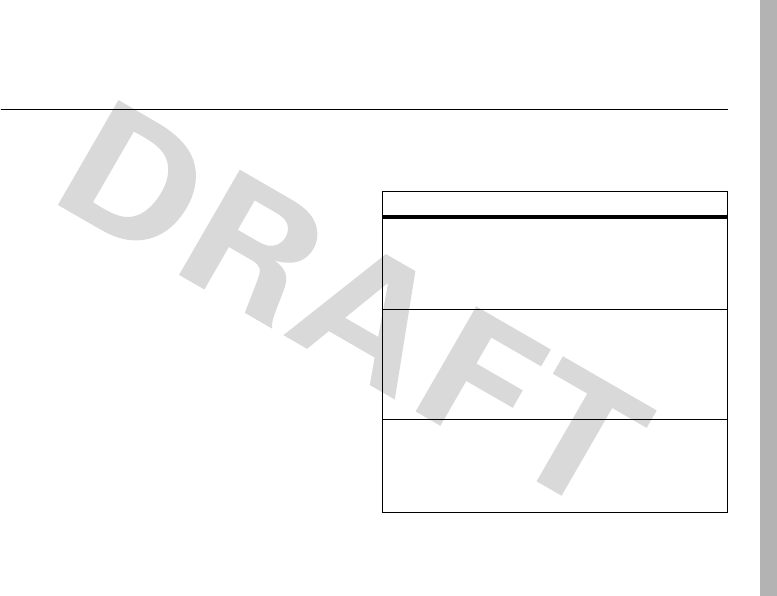
Warranty
105
Motorola Limited Warranty for the United States and
Canada
Warranty
What Does this Warranty Cover?
Subject to the exclusions contained below, Motorola, Inc. warrants
its telephones, pagers, messaging devices, and consumer and
professional two-way radios (excluding commercial, government
or industrial radios) that operate via Family Radio Service or
General Mobile Radio Service, Motorola-branded or certified
accessories sold for use with these Products (“Accessories”) and
Motorola software contained on CD-ROMs or other tangible media
and sold for use with these Products (“Software”) to be free from
defects in materials and workmanship under normal consumer
usage for the period(s) outlined below. This limited warranty is a
consumer's exclusive remedy, and applies as follows to new
Motorola Products, Accessories and Software purchased by
consumers in the United States or Canada, which are accompanied
by this written warranty:
Products and Accessories
Products Covered Length of Coverage
Products and
Accessories
as
defined above, unless
otherwise provided for
below.
One (1) year
from the date of
purchase by the first consumer
purchaser of the product unless
otherwise provided for below.
Decorative
Accessories and
Cases.
Decorative
covers, bezels,
PhoneWrap™ covers
and cases.
Limited lifetime warranty
for the
lifetime of ownership by the first
consumer purchaser of the product.
Monaural Headsets.
Ear buds and boom
headsets that transmit
mono sound through a
wired connection.
Limited lifetime warranty
for the
lifetime of ownership by the first
consumer purchaser of the product.
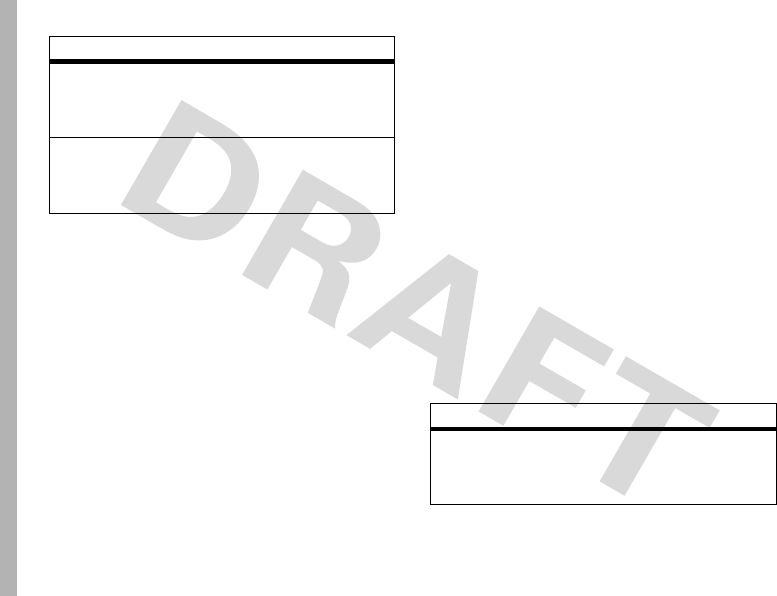
106
Warranty
Exclusions
Normal Wear and Tear.
Periodic maintenance, repair and
replacement of parts due to normal wear and tear are excluded
from coverage.
Batteries.
Only batteries whose fully charged capacity falls below
80% of their rated capacity and batteries that leak are covered by
this limited warranty.
Abuse & Misuse.
Defects or damage that result from:
(a) improper operation, storage, misuse or abuse, accident or
neglect, such as physical damage (cracks, scratches, etc.) to the
surface of the product resulting from misuse; (b) contact with
liquid, water, rain, extreme humidity or heavy perspiration, sand,
dirt or the like, extreme heat, or food; (c) use of the Products or
Accessories for commercial purposes or subjecting the Product or
Accessory to abnormal usage or conditions; or (d) other acts which
are not the fault of Motorola, are excluded from coverage.
Use of Non-Motorola Products and Accessories.
Defects or
damage that result from the use of Non-Motorola branded or
certified Products, Accessories, Software or other peripheral
equipment are excluded from coverage.
Unauthorized Service or Modification.
Defects or damages
resulting from service, testing, adjustment, installation,
maintenance, alteration, or modification in any way by someone
other than Motorola, or its authorized service centers, are
excluded from coverage.
Altered Products.
Products or Accessories with (a) serial
numbers or date tags that have been removed, altered or
obliterated; (b) broken seals or that show evidence of tampering;
(c) mismatched board serial numbers; or (d) nonconforming or
non-Motorola housings, or parts, are excluded from coverage.
Communication Services.
Defects, damages, or the failure of
Products, Accessories or Software due to any communication
service or signal you may subscribe to or use with the Products
Accessories or Software is excluded from coverage.
Software
Consumer and
Professional
Two-Way Radio
Accessories.
Ninety (90) days
from the date of
purchase by the first consumer
purchaser of the product.
Products and
Accessories that are
Repaired or
Replaced.
The balance of the original
warranty or for ninety (90) days
from the date returned to the
consumer, whichever is longer.
Products Covered Length of Coverage
Products Covered Length of Coverage
Software.
Applies only to physical
defects in the media that embodies
the copy of the software (e.g.
CD-ROM, or floppy disk).
Ninety (90) days
from
the date of purchase.
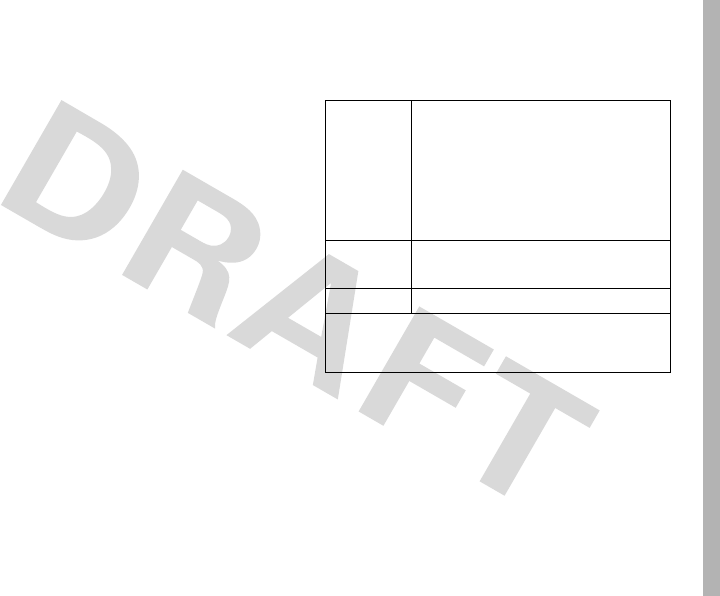
Warranty
107
Exclusions
Software Embodied in Physical Media.
No warranty is made
that the software will meet your requirements or will work in
combination with any hardware or software applications provided
by third parties, that the operation of the software products will be
uninterrupted or error free, or that all defects in the software
products will be corrected.
Software NOT Embodied in Physical Media.
Software that is
not embodied in physical media (e.g. software that is downloaded
from the internet), is provided “as is” and without warranty.
Who Is Covered?
This warranty extends only to the first consumer purchaser, and is
not transferable.
What Will Motorola Do?
Motorola, at its option, will at no charge repair, replace or refund
the purchase price of any Products, Accessories or Software that
does not conform to this warranty. We may use functionally
equivalent reconditioned/refurbished/pre-owned or new Products,
Accessories or parts. No data, software or applications added to
your Product, Accessory or Software, including but not limited to
personal contacts, games and ringer tones, will be reinstalled. To
avoid losing such data, software and applications please create a
back up prior to requesting service.
How to Obtain Warranty Service or
Other Information
You will receive instructions on how to ship the Products,
Accessories or Software, at your expense, to a Motorola
Authorized Repair Center. To obtain service, you must include: (a) a
copy of your receipt, bill of sale or other comparable proof of
purchase; (b) a written description of the problem; (c) the name of
your service provider, if applicable; (d) the name and location of the
installation facility (if applicable) and, most importantly; (e) your
address and telephone number.
USA Phones
1-800-331-6456
Pagers
1-800-548-9954
Two-Way Radios and Messaging Devices
1-800-353-2729
Canada All Products
1-800-461-4575
TTY
1-888-390-6456
For
Accessories
and
Software
, please call the telephone
number designated above for the product with which they are
used.

108
Warranty
What Other Limitations Are There?
ANY IMPLIED WARRANTIES, INCLUDING WITHOUT LIMITATION
THE IMPLIED WARRANTIES OF MERCHANTABILITY AND FITNESS
FOR A PARTICULAR PURPOSE, SHALL BE LIMITED TO THE
DURATION OF THIS LIMITED WARRANTY, OTHERWISE THE
REPAIR, REPLACEMENT, OR REFUND AS PROVIDED UNDER THIS
EXPRESS LIMITED WARRANTY IS THE EXCLUSIVE REMEDY OF
THE CONSUMER, AND IS PROVIDED IN LIEU OF ALL OTHER
WARRANTIES, EXPRESS OR IMPLIED. IN NO EVENT SHALL
MOTOROLA BE LIABLE, WHETHER IN CONTRACT OR TORT
(INCLUDING NEGLIGENCE) FOR DAMAGES IN EXCESS OF THE
PURCHASE PRICE OF THE PRODUCT, ACCESSORY OR SOFTWARE,
OR FOR ANY INDIRECT, INCIDENTAL, SPECIAL OR
CONSEQUENTIAL DAMAGES OF ANY KIND, OR LOSS OF
REVENUE OR PROFITS, LOSS OF BUSINESS, LOSS OF
INFORMATION OR DATA, SOFTWARE OR APPLICATIONS OR
OTHER FINANCIAL LOSS ARISING OUT OF OR IN CONNECTION
WITH THE ABILITY OR INABILITY TO USE THE PRODUCTS,
ACCESSORIES OR SOFTWARE TO THE FULL EXTENT THESE
DAMAGES MAY BE DISCLAIMED BY LAW.
Some states and jurisdictions do not allow the limitation or
exclusion of incidental or consequential damages, or
limitation on the length of an implied warranty, so the
above limitations or exclusions may not apply to you. This
warranty gives you specific legal rights, and you may also
have other rights that vary from state to state or from one
jurisdiction to another.
Laws in the United States and other countries preserve for
Motorola certain exclusive rights for copyrighted Motorola
software such as the exclusive rights to reproduce and distribute
copies of the Motorola software. Motorola software may only be
copied into, used in, and redistributed with, the Products
associated with such Motorola software. No other use, including
without limitation disassembly of such Motorola software or
exercise of the exclusive rights reserved for Motorola, is
permitted.

Hearing Aids
109
Hearing Aid Compatibility with Mobile Phones
Hearing Aids
Some Motorola phones are measured for compatibility with
hearing aids. If the box for your particular model has “Rated for
Hearing Aids” printed on it, the following explanation applies.
When some mobile phones are used near some hearing devices
(hearing aids and cochlear implants), users may detect a buzzing,
humming, or whining noise. Some hearing devices are more
immune than others to this interference noise, and phones also
vary in the amount of interference they generate.
The wireless telephone industry has developed ratings for some of
their mobile phones, to assist hearing device users in finding
phones that may be compatible with their hearing devices. Not all
phones have been rated. Phones that are rated have the rating on
their box or a label on the box.
The ratings are not guarantees. Results will vary depending on the
user’s hearing device and hearing loss. If your hearing device
happens to be vulnerable to interference, you may not be able to
use a rated phone successfully. Trying out the phone with your
hearing device is the best way to evaluate it for your personal
needs.
M-Ratings:
Phones rated M3 or M4 meet FCC requirements and
are likely to generate less interference to hearing devices than
phones that are not labeled. M4 is the better/higher of the two
ratings.
T-Ratings:
Phones rated T3 or T4 meet FCC requirements and are
likely to be more usable with a hearing device’s telecoil (“T
Switch” or “Telephone Switch”) than unrated phones. T4 is the
better/higher of the two ratings. (Note that not all hearing devices
have telecoils in them.)
Hearing devices may also be measured for immunity to this type of
interference. Your hearing device manufacturer or hearing health
professional may help you find results for your hearing device. The
more immune your hearing aid is, the less likely you are to
experience interference noise from mobile phones.

110
WHO Information
Information from the World Health Organization
WHO Info rmation
Present scientific information does not indicate the need for any
special precautions for the use of mobile phones. If you are
concerned, you may want to limit your own or your children’s RF
exposure by limiting the length of calls or by using handsfree
devices to keep mobile phones away from your head and body.
Source: WHO Fact Sheet 193
Further information:
http://www.who.int./peh-emf
Product Registration
Registration
Online Product Registration:
direct.motorola.com/hellomoto/
Motosupport/source/registration.asp
Product registration is an important step toward enjoying your new
Motorola product. Registering helps us facilitate warranty service,
and permits us to contact you should your product require an
update or other service. Registration is for U.S. residents only and
is not required for warranty coverage.
Please retain your original dated sales receipt for your records. For
warranty service of your Motorola Personal Communications
Product you will need to provide a copy of your dated sales receipt
to confirm warranty status.
Thank you for choosing a Motorola product.

Export Law
111
Export Law Assurances
Export Law
This product is controlled under the export regulations of the
United States of America and Canada. The Governments of the
United States of America and Canada may restrict the exportation
or re-exportation of this product to certain destinations. For further
information contact the U.S. Department of Commerce or the
Canadian Department of Foreign Affairs and International Trade.
Wireless: The New Recyclable
Recycl ing
Your wireless mobile device can be recycled. Recycling your
mobile device reduces the amount of waste disposed in landfills
and allows recycled materials to be incorporated into new
products.
The Cellular Telecommunications Industry Association (CTIA) and
its members encourage consumers to recycle their mobile devices
and have taken steps to promote the collection and
environmentally sound recycling of end-of-life devices.
As a mobile device user, you have an important role in ensuring
that this device is recycled properly. When it comes time to give
this mobile device up or trade it in for a new one, please remember
that the mobile device, the charger, and many of its accessories
can be recycled. It's easy. To learn more about CTIA's Recycling
Program for Used Wireless Devices, please visit us at:
recycling.motorola.young-america.com/
index.html

112
Perchlorate Label
California Perchlorate Label
Perchlorat e Label
Some mobile phones use an internal, permanent backup battery on
the printed circuit board that may contain very small amounts of
perchlorate. In such cases, California law requires the following
label:
"Perchlorate Material – special handling may apply. See
www.dtsc.ca.gov/hazardouswaste/
perchlorate
."
There is no special handling required by consumers.
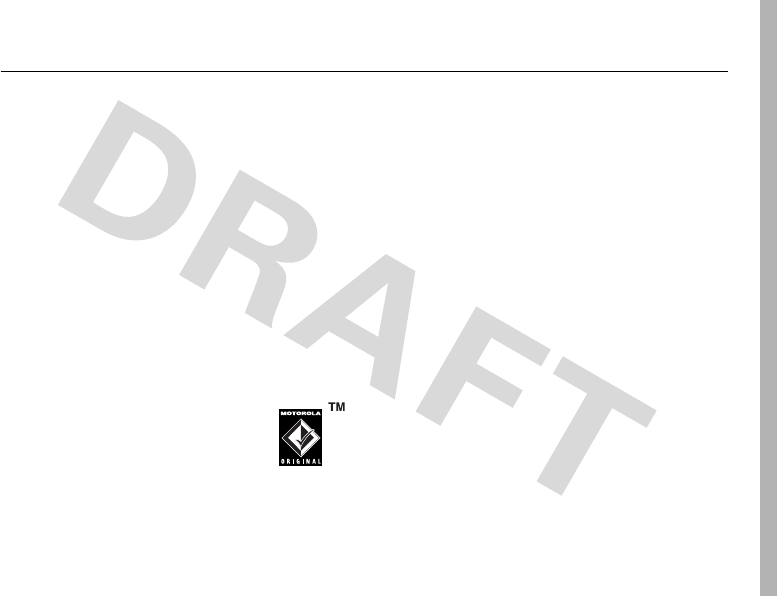
Driving Safety
113
Smart Practices While Driving
Drivin g Safety
Drive Safe, Call Smart
SM
Check the laws and regulations on the use of mobile
devices and their accessories in the areas where you drive.
Always obey them. The use of these devices may be
prohibited or restricted in certain areas. Go to
www.motorola.com/callsmart
for more
information.
Your mobile device lets you communicate by voice and
data—almost anywhere, anytime, wherever wireless service is
available and safe conditions allow. When driving a car, driving is
your first responsibility. If you choose to use your mobile device
while driving, remember the following tips:
• Get to know your Motorola mobile device and its
features such as speed dial and redial.
If available,
these features help you to place your call without taking
your attention off the road.
• When available, use a handsfree
device.
If possible, add an additional
layer of convenience to your mobile device
with one of the many Motorola Original
handsfree accessories available today.
• Position your mobile device within easy reach.
Be
able to access your mobile device without removing your
eyes from the road. If you receive an incoming call at an
inconvenient time, if possible, let your voice mail answer
it for you.
• Let the person you are speaking with know you are
driving; if necessary, suspend the call in heavy
traffic or hazardous weather conditions.
Rain, sleet,
snow, ice, and even heavy traffic can be hazardous.
• Do not take notes or look up phone numbers while
driving.
Jotting down a “to do” list or going through your
address book takes attention away from your primary
responsibility—driving safely.
• Dial sensibly and assess the traffic; if possible,
place calls when your car is not moving or before
pulling into traffic.
If you must make a call while
moving, dial only a few numbers, check the road and your
mirrors, then continue.
• Do not engage in stressful or emotional
conversations that may be distracting.
Make people
you are talking with aware you are driving and suspend
conversations that can divert your attention away from the
road.

114
Driving Safety
• Use your mobile device to call for help.
Dial 911 or
other local emergency number in the case of fire, traffic
accident, or medical emergencies.*
• Use your mobile device to help others in
emergencies.
If you see an auto accident, crime in
progress, or other serious emergency where lives are in
danger, call 911 or other local emergency number, as you
would want others to do for you.*
• Call roadside assistance or a special
non-emergency wireless assistance number when
necessary.
If you see a broken-down vehicle posing no
serious hazard, a broken traffic signal, a minor traffic
accident where no one appears injured, or a vehicle you
know to be stolen, call roadside assistance or other
special non-emergency wireless number.*
* Wherever wireless phone service is available.

index
115
index
Numerics
1X indicator 19
A
accessories 12
airplane mode indicator 20
alarm clock 90
alert
set 38
turn off 44
answer a call 15, 46
attach a number 45
B
backlight 40
banner 84
battery 13, 14
charge indicator light 2
extending battery life 12
level indicator 19
Bluetooth
connection indicator 20
indicator light 2
brightness 40
browser 92
C
cable connection 34
cables 58
calculator 90
call
answer 15, 46
end 15
external speakerphone 87
make 15
call times 86
caller ID 77
camera 3
camera key 3
capitalize text 23
car kit 86
CD, ripping 61
center key 2
clear/back key 2
clock
analog 84
digital 84
codes 30
computer
pairing 56

116
index
Contacts 45, 76
create entry 76, 77
create mailing list 78
manage entries 79
print 78
set category view 79
set entry category 78
set entry view 78
set speed dial 77
copy music onto phone 59
D
data call 88
indicator tethered
indicator 19
volume meters 86
data times 86
dial a phone number 15
dialed calls 44
digital indicator 19
display 4, 18
brightness 40
drafts folder 80
E
embedded WAP/BREW
indicator 19
emergency number 47
end a call 15
end key 2, 15
Enter Unlock Code message
30
export regulations 111
F
fax call 88
file types 59
G
greeting 83
H
handsfree
pairing 56
speaker 3, 29
use 86
headset
accessory, using 86
pairing 56
hearing aids 109
home screen 4, 18
shortcuts 21
soft key indicators 83
I
indicators
1X 19
airplane mode 20
battery level 19
Bluetooth connection 20

index
117
data call/tethered/
embedded WAP/
BREW 19
digital 19
location on 19
message 20
no service 19
phone locked 19
roaming 18
signal strength 18
sound on & vibrate on 20
sounds loud 19
sounds off (silent) 19
sounds soft 19
speakerphone 20
text entry mode 24
uanswered call 19
voice call 19
iTAP text entry method 26
K
keypad volume 83
L
layout
text 84
location on indicator 19
lock
phone 30
slider 14, 28
M
make a call 15
master clear 85
master reset 85
memory card
loading music files 60
reader 36
menu 4, 21, 22
icons, show or hide 84
language 84
scroll 84
show icons or list 84
menu icons 21, 22
message
drafts 80
erase 81
MMS template 79
quick text 80
text message 79
view sent message 80
message indicator 20
mini-USB port 3
Missed Calls message 46
MMS template 79
music 59
loading onto memory card
60
loading onto phone 59
music player 59
playing 62

118
index
transfer from CD 61
updating song list 62
N
navigation key 2, 11, 18
network settings 89
no service indicator 19
notepad 46
number. See phone number
numeric entry method 27
O
open to answer 46
optional accessory 12
optional feature 11
P
pair with device 56
passwords. See codes
perchlorate label 112
phone
network settings 89
talking phone 41
phone locked indicator 19
phone number 16
phonebook 76
picture ID 77
play music 62
power key 2, 14
push bar 2, 3
Q
quick text 80
R
received calls 44
recent calls 44
recycling 111
redial 44
reminders 83
return a call 46
ring style, setting 38
ring volume 83
ringer ID 77
rip CD 61
roaming indicator 18
S
safety
information 98
tips 113
security code 30
send key 2, 15
shortcuts 17
signal strength indicator 18
skin 83
slider closed, display 27
smart key 3
soft keys 2, 18
indicators 83
song list 62

index
119
sound on & vibrate on
indicator 20
sounds
loud indicator 19
soft indicator 19
sounds off (silent) indicator
19
speaker 29
speakerphone
automatic answer 87
speakerphone indicator 20
speakerphone, external
activating 87
store your number 16
symbol entry mode 27
T
tap text entry method 24
telephone number. See
phone number
text entry 22
capitalization 23
entry mode indicators 24
text layout 84
tips & tricks 17
turn on/off 14
U
unanswered call indicator 19
unlock
code 30
phone 30
slider 14, 28
USB cables 58
V
voice call indicator 19
voice command key 3
voice dial 76, 87
voicemail 49
voicemail message indicator
49
volume
keypad 83
keys 3
ring 83
W
wallpaper 39
warranty 105
WHO information 110
Y
your phone number 16
U.S. patent Re. 34,976

120
index